Business Analysis of AirAsia Berhad | Report
VerifiedAdded on 2022/08/13
|18
|4931
|28
AI Summary
Contribute Materials
Your contribution can guide someone’s learning journey. Share your
documents today.
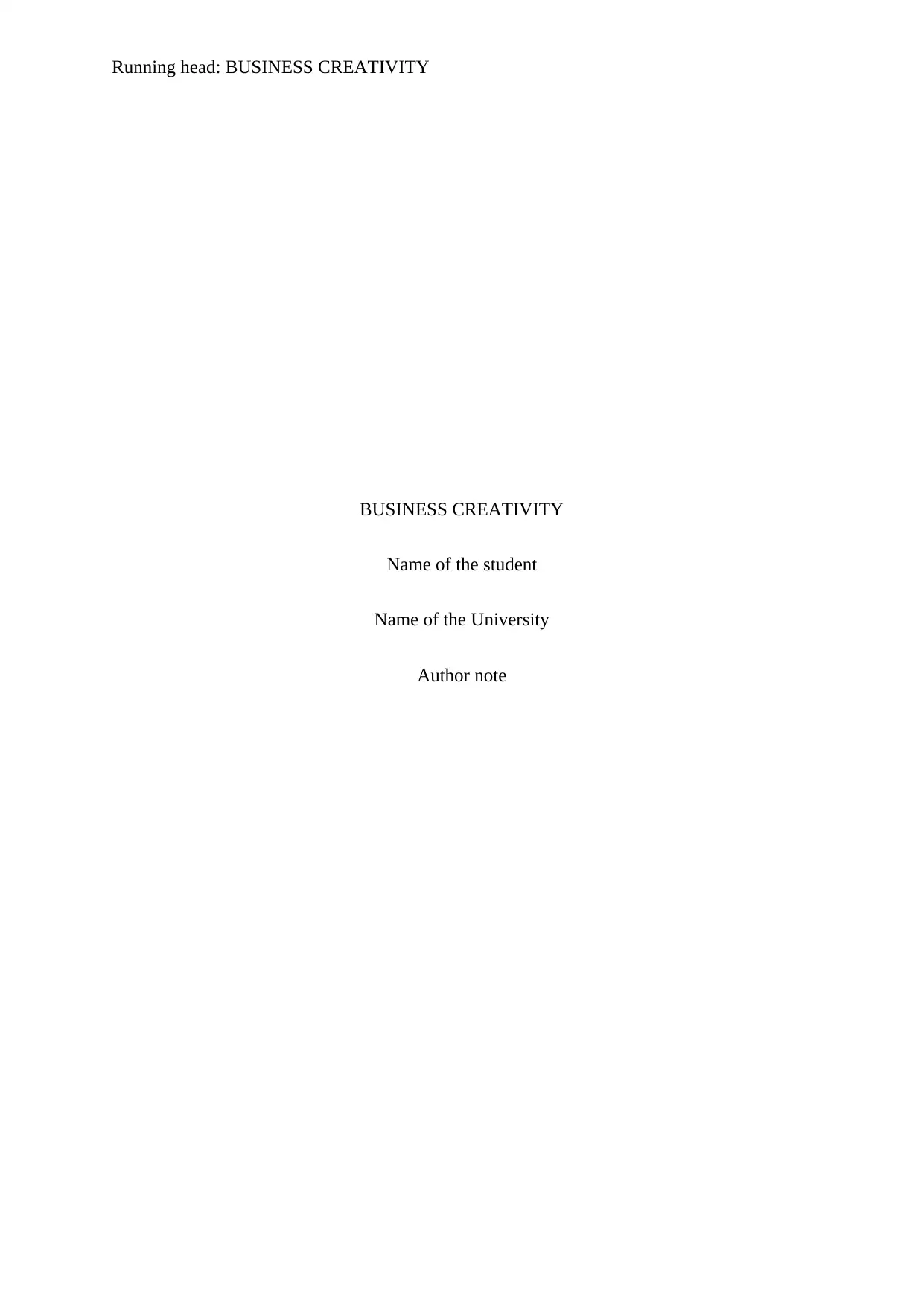
Running head: BUSINESS CREATIVITY
BUSINESS CREATIVITY
Name of the student
Name of the University
Author note
BUSINESS CREATIVITY
Name of the student
Name of the University
Author note
Secure Best Marks with AI Grader
Need help grading? Try our AI Grader for instant feedback on your assignments.
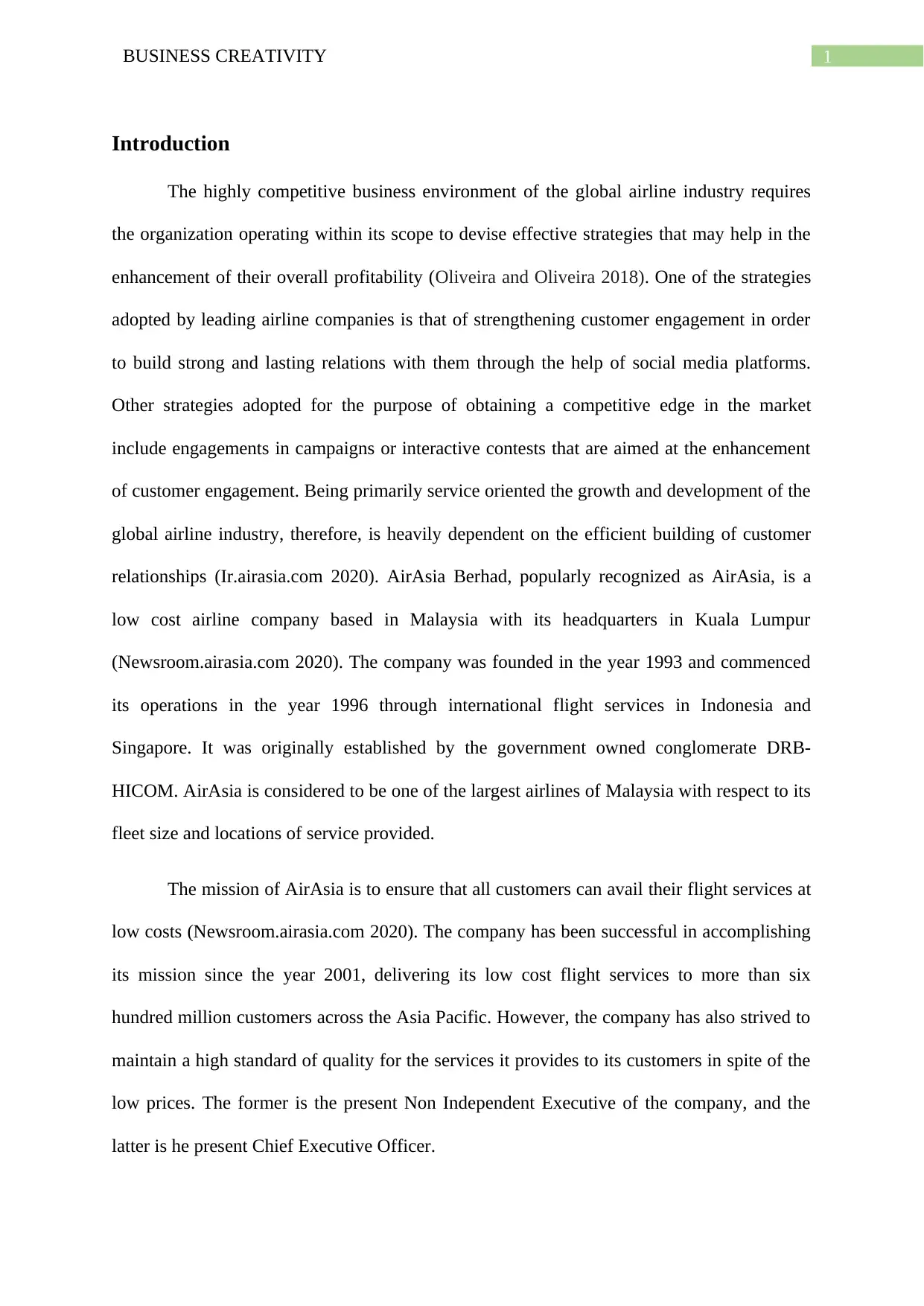
1BUSINESS CREATIVITY
Introduction
The highly competitive business environment of the global airline industry requires
the organization operating within its scope to devise effective strategies that may help in the
enhancement of their overall profitability (Oliveira and Oliveira 2018). One of the strategies
adopted by leading airline companies is that of strengthening customer engagement in order
to build strong and lasting relations with them through the help of social media platforms.
Other strategies adopted for the purpose of obtaining a competitive edge in the market
include engagements in campaigns or interactive contests that are aimed at the enhancement
of customer engagement. Being primarily service oriented the growth and development of the
global airline industry, therefore, is heavily dependent on the efficient building of customer
relationships (Ir.airasia.com 2020). AirAsia Berhad, popularly recognized as AirAsia, is a
low cost airline company based in Malaysia with its headquarters in Kuala Lumpur
(Newsroom.airasia.com 2020). The company was founded in the year 1993 and commenced
its operations in the year 1996 through international flight services in Indonesia and
Singapore. It was originally established by the government owned conglomerate DRB-
HICOM. AirAsia is considered to be one of the largest airlines of Malaysia with respect to its
fleet size and locations of service provided.
The mission of AirAsia is to ensure that all customers can avail their flight services at
low costs (Newsroom.airasia.com 2020). The company has been successful in accomplishing
its mission since the year 2001, delivering its low cost flight services to more than six
hundred million customers across the Asia Pacific. However, the company has also strived to
maintain a high standard of quality for the services it provides to its customers in spite of the
low prices. The former is the present Non Independent Executive of the company, and the
latter is he present Chief Executive Officer.
Introduction
The highly competitive business environment of the global airline industry requires
the organization operating within its scope to devise effective strategies that may help in the
enhancement of their overall profitability (Oliveira and Oliveira 2018). One of the strategies
adopted by leading airline companies is that of strengthening customer engagement in order
to build strong and lasting relations with them through the help of social media platforms.
Other strategies adopted for the purpose of obtaining a competitive edge in the market
include engagements in campaigns or interactive contests that are aimed at the enhancement
of customer engagement. Being primarily service oriented the growth and development of the
global airline industry, therefore, is heavily dependent on the efficient building of customer
relationships (Ir.airasia.com 2020). AirAsia Berhad, popularly recognized as AirAsia, is a
low cost airline company based in Malaysia with its headquarters in Kuala Lumpur
(Newsroom.airasia.com 2020). The company was founded in the year 1993 and commenced
its operations in the year 1996 through international flight services in Indonesia and
Singapore. It was originally established by the government owned conglomerate DRB-
HICOM. AirAsia is considered to be one of the largest airlines of Malaysia with respect to its
fleet size and locations of service provided.
The mission of AirAsia is to ensure that all customers can avail their flight services at
low costs (Newsroom.airasia.com 2020). The company has been successful in accomplishing
its mission since the year 2001, delivering its low cost flight services to more than six
hundred million customers across the Asia Pacific. However, the company has also strived to
maintain a high standard of quality for the services it provides to its customers in spite of the
low prices. The former is the present Non Independent Executive of the company, and the
latter is he present Chief Executive Officer.
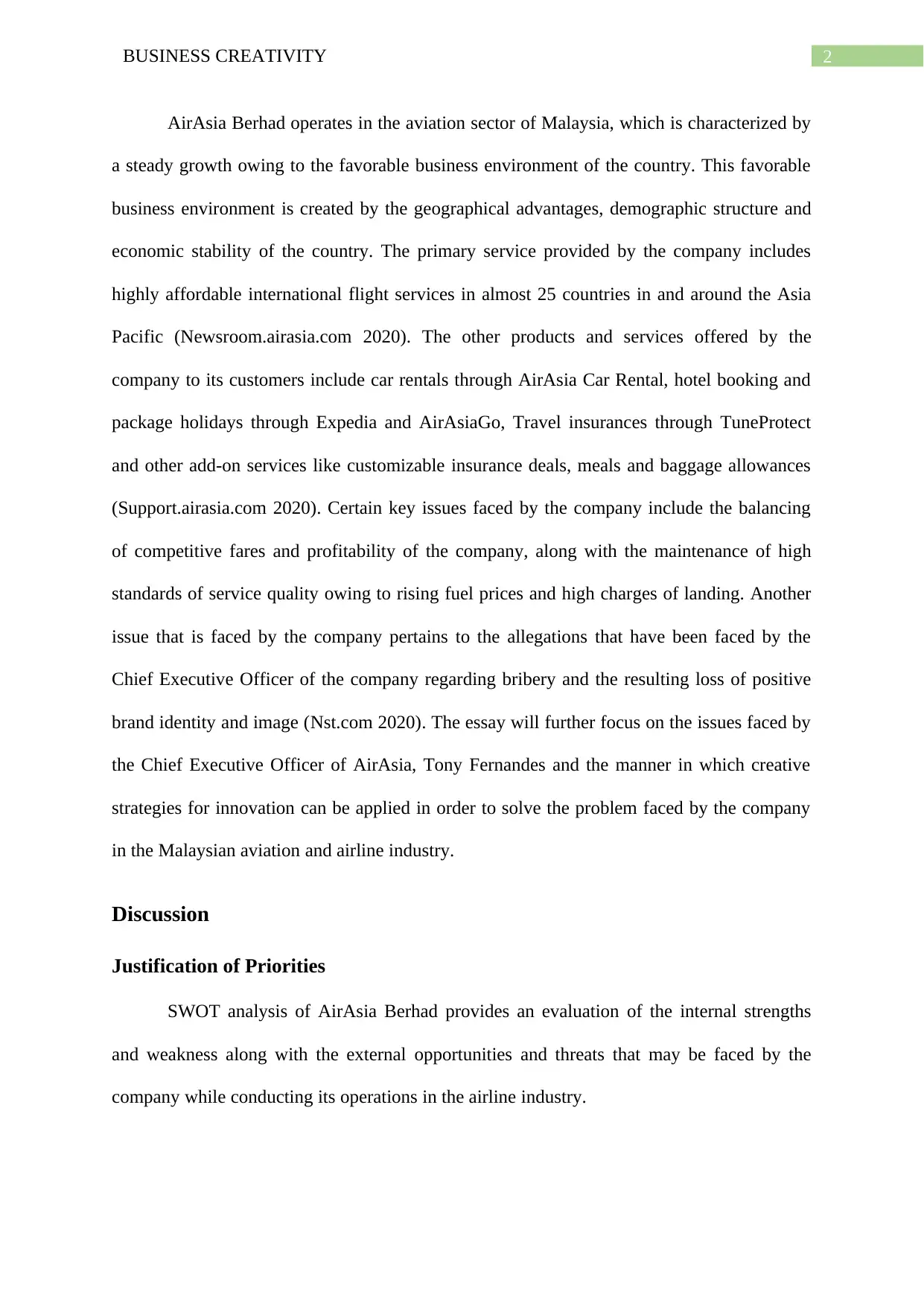
2BUSINESS CREATIVITY
AirAsia Berhad operates in the aviation sector of Malaysia, which is characterized by
a steady growth owing to the favorable business environment of the country. This favorable
business environment is created by the geographical advantages, demographic structure and
economic stability of the country. The primary service provided by the company includes
highly affordable international flight services in almost 25 countries in and around the Asia
Pacific (Newsroom.airasia.com 2020). The other products and services offered by the
company to its customers include car rentals through AirAsia Car Rental, hotel booking and
package holidays through Expedia and AirAsiaGo, Travel insurances through TuneProtect
and other add-on services like customizable insurance deals, meals and baggage allowances
(Support.airasia.com 2020). Certain key issues faced by the company include the balancing
of competitive fares and profitability of the company, along with the maintenance of high
standards of service quality owing to rising fuel prices and high charges of landing. Another
issue that is faced by the company pertains to the allegations that have been faced by the
Chief Executive Officer of the company regarding bribery and the resulting loss of positive
brand identity and image (Nst.com 2020). The essay will further focus on the issues faced by
the Chief Executive Officer of AirAsia, Tony Fernandes and the manner in which creative
strategies for innovation can be applied in order to solve the problem faced by the company
in the Malaysian aviation and airline industry.
Discussion
Justification of Priorities
SWOT analysis of AirAsia Berhad provides an evaluation of the internal strengths
and weakness along with the external opportunities and threats that may be faced by the
company while conducting its operations in the airline industry.
AirAsia Berhad operates in the aviation sector of Malaysia, which is characterized by
a steady growth owing to the favorable business environment of the country. This favorable
business environment is created by the geographical advantages, demographic structure and
economic stability of the country. The primary service provided by the company includes
highly affordable international flight services in almost 25 countries in and around the Asia
Pacific (Newsroom.airasia.com 2020). The other products and services offered by the
company to its customers include car rentals through AirAsia Car Rental, hotel booking and
package holidays through Expedia and AirAsiaGo, Travel insurances through TuneProtect
and other add-on services like customizable insurance deals, meals and baggage allowances
(Support.airasia.com 2020). Certain key issues faced by the company include the balancing
of competitive fares and profitability of the company, along with the maintenance of high
standards of service quality owing to rising fuel prices and high charges of landing. Another
issue that is faced by the company pertains to the allegations that have been faced by the
Chief Executive Officer of the company regarding bribery and the resulting loss of positive
brand identity and image (Nst.com 2020). The essay will further focus on the issues faced by
the Chief Executive Officer of AirAsia, Tony Fernandes and the manner in which creative
strategies for innovation can be applied in order to solve the problem faced by the company
in the Malaysian aviation and airline industry.
Discussion
Justification of Priorities
SWOT analysis of AirAsia Berhad provides an evaluation of the internal strengths
and weakness along with the external opportunities and threats that may be faced by the
company while conducting its operations in the airline industry.
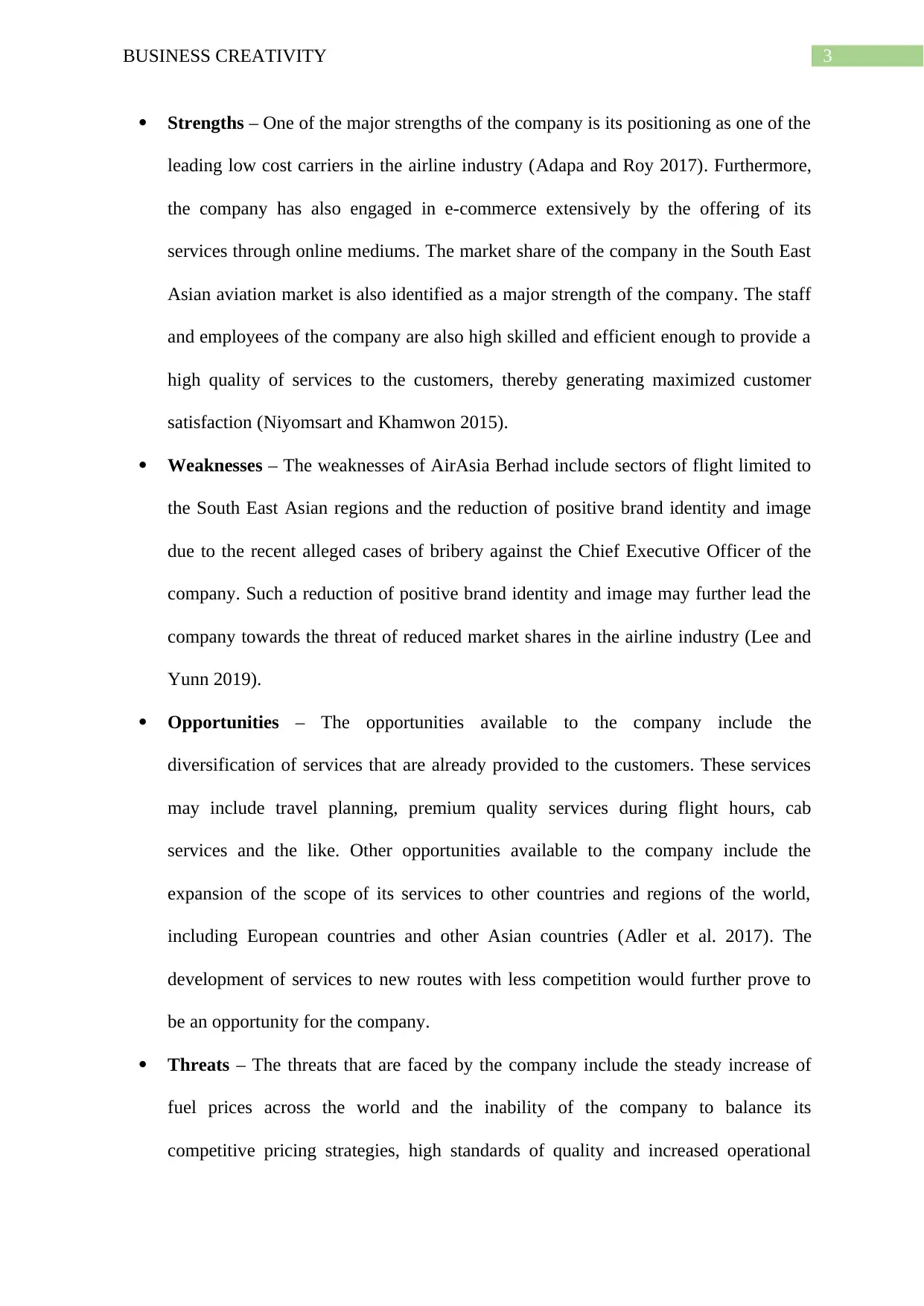
3BUSINESS CREATIVITY
Strengths – One of the major strengths of the company is its positioning as one of the
leading low cost carriers in the airline industry (Adapa and Roy 2017). Furthermore,
the company has also engaged in e-commerce extensively by the offering of its
services through online mediums. The market share of the company in the South East
Asian aviation market is also identified as a major strength of the company. The staff
and employees of the company are also high skilled and efficient enough to provide a
high quality of services to the customers, thereby generating maximized customer
satisfaction (Niyomsart and Khamwon 2015).
Weaknesses – The weaknesses of AirAsia Berhad include sectors of flight limited to
the South East Asian regions and the reduction of positive brand identity and image
due to the recent alleged cases of bribery against the Chief Executive Officer of the
company. Such a reduction of positive brand identity and image may further lead the
company towards the threat of reduced market shares in the airline industry (Lee and
Yunn 2019).
Opportunities – The opportunities available to the company include the
diversification of services that are already provided to the customers. These services
may include travel planning, premium quality services during flight hours, cab
services and the like. Other opportunities available to the company include the
expansion of the scope of its services to other countries and regions of the world,
including European countries and other Asian countries (Adler et al. 2017). The
development of services to new routes with less competition would further prove to
be an opportunity for the company.
Threats – The threats that are faced by the company include the steady increase of
fuel prices across the world and the inability of the company to balance its
competitive pricing strategies, high standards of quality and increased operational
Strengths – One of the major strengths of the company is its positioning as one of the
leading low cost carriers in the airline industry (Adapa and Roy 2017). Furthermore,
the company has also engaged in e-commerce extensively by the offering of its
services through online mediums. The market share of the company in the South East
Asian aviation market is also identified as a major strength of the company. The staff
and employees of the company are also high skilled and efficient enough to provide a
high quality of services to the customers, thereby generating maximized customer
satisfaction (Niyomsart and Khamwon 2015).
Weaknesses – The weaknesses of AirAsia Berhad include sectors of flight limited to
the South East Asian regions and the reduction of positive brand identity and image
due to the recent alleged cases of bribery against the Chief Executive Officer of the
company. Such a reduction of positive brand identity and image may further lead the
company towards the threat of reduced market shares in the airline industry (Lee and
Yunn 2019).
Opportunities – The opportunities available to the company include the
diversification of services that are already provided to the customers. These services
may include travel planning, premium quality services during flight hours, cab
services and the like. Other opportunities available to the company include the
expansion of the scope of its services to other countries and regions of the world,
including European countries and other Asian countries (Adler et al. 2017). The
development of services to new routes with less competition would further prove to
be an opportunity for the company.
Threats – The threats that are faced by the company include the steady increase of
fuel prices across the world and the inability of the company to balance its
competitive pricing strategies, high standards of quality and increased operational
Secure Best Marks with AI Grader
Need help grading? Try our AI Grader for instant feedback on your assignments.
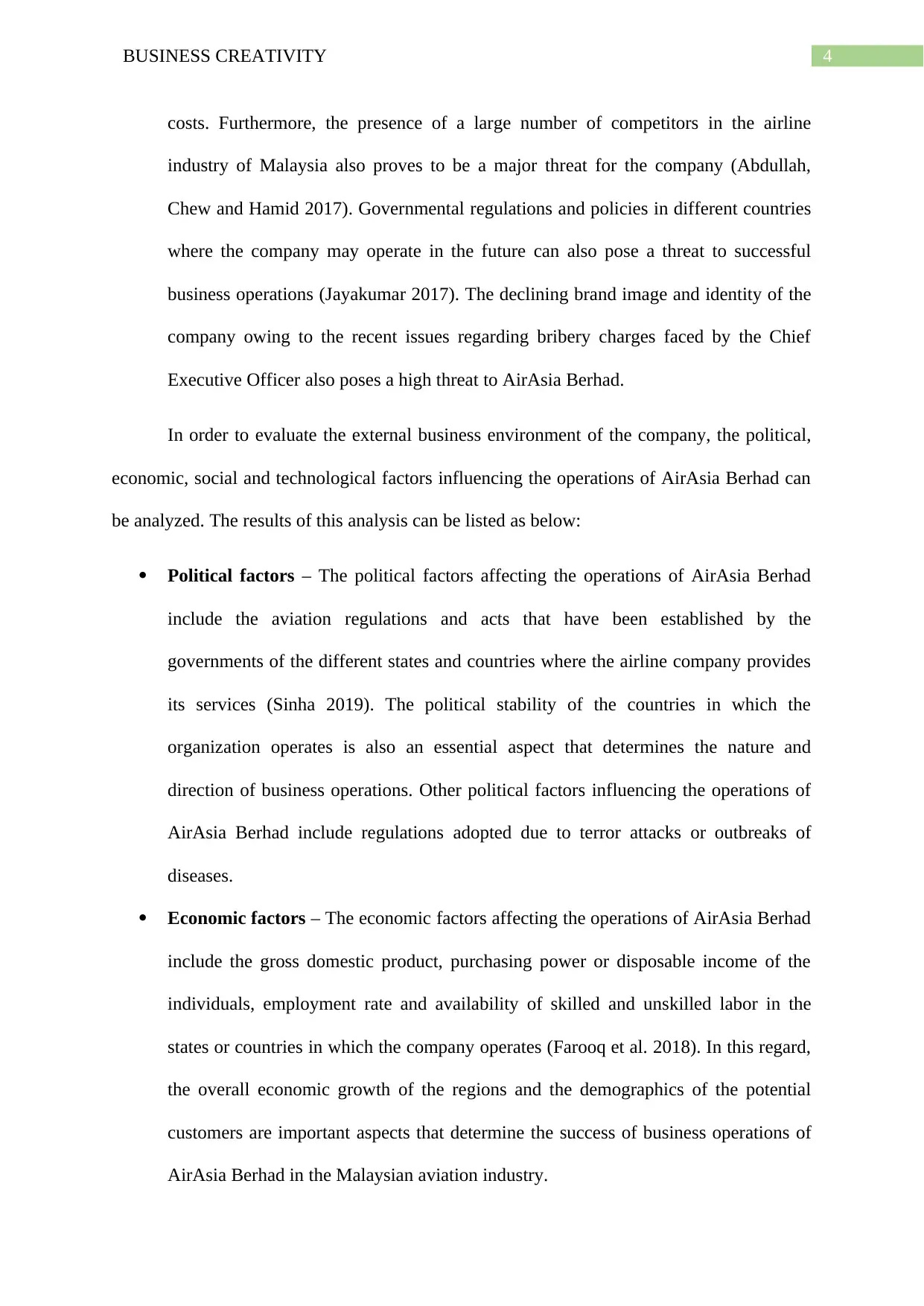
4BUSINESS CREATIVITY
costs. Furthermore, the presence of a large number of competitors in the airline
industry of Malaysia also proves to be a major threat for the company (Abdullah,
Chew and Hamid 2017). Governmental regulations and policies in different countries
where the company may operate in the future can also pose a threat to successful
business operations (Jayakumar 2017). The declining brand image and identity of the
company owing to the recent issues regarding bribery charges faced by the Chief
Executive Officer also poses a high threat to AirAsia Berhad.
In order to evaluate the external business environment of the company, the political,
economic, social and technological factors influencing the operations of AirAsia Berhad can
be analyzed. The results of this analysis can be listed as below:
Political factors – The political factors affecting the operations of AirAsia Berhad
include the aviation regulations and acts that have been established by the
governments of the different states and countries where the airline company provides
its services (Sinha 2019). The political stability of the countries in which the
organization operates is also an essential aspect that determines the nature and
direction of business operations. Other political factors influencing the operations of
AirAsia Berhad include regulations adopted due to terror attacks or outbreaks of
diseases.
Economic factors – The economic factors affecting the operations of AirAsia Berhad
include the gross domestic product, purchasing power or disposable income of the
individuals, employment rate and availability of skilled and unskilled labor in the
states or countries in which the company operates (Farooq et al. 2018). In this regard,
the overall economic growth of the regions and the demographics of the potential
customers are important aspects that determine the success of business operations of
AirAsia Berhad in the Malaysian aviation industry.
costs. Furthermore, the presence of a large number of competitors in the airline
industry of Malaysia also proves to be a major threat for the company (Abdullah,
Chew and Hamid 2017). Governmental regulations and policies in different countries
where the company may operate in the future can also pose a threat to successful
business operations (Jayakumar 2017). The declining brand image and identity of the
company owing to the recent issues regarding bribery charges faced by the Chief
Executive Officer also poses a high threat to AirAsia Berhad.
In order to evaluate the external business environment of the company, the political,
economic, social and technological factors influencing the operations of AirAsia Berhad can
be analyzed. The results of this analysis can be listed as below:
Political factors – The political factors affecting the operations of AirAsia Berhad
include the aviation regulations and acts that have been established by the
governments of the different states and countries where the airline company provides
its services (Sinha 2019). The political stability of the countries in which the
organization operates is also an essential aspect that determines the nature and
direction of business operations. Other political factors influencing the operations of
AirAsia Berhad include regulations adopted due to terror attacks or outbreaks of
diseases.
Economic factors – The economic factors affecting the operations of AirAsia Berhad
include the gross domestic product, purchasing power or disposable income of the
individuals, employment rate and availability of skilled and unskilled labor in the
states or countries in which the company operates (Farooq et al. 2018). In this regard,
the overall economic growth of the regions and the demographics of the potential
customers are important aspects that determine the success of business operations of
AirAsia Berhad in the Malaysian aviation industry.
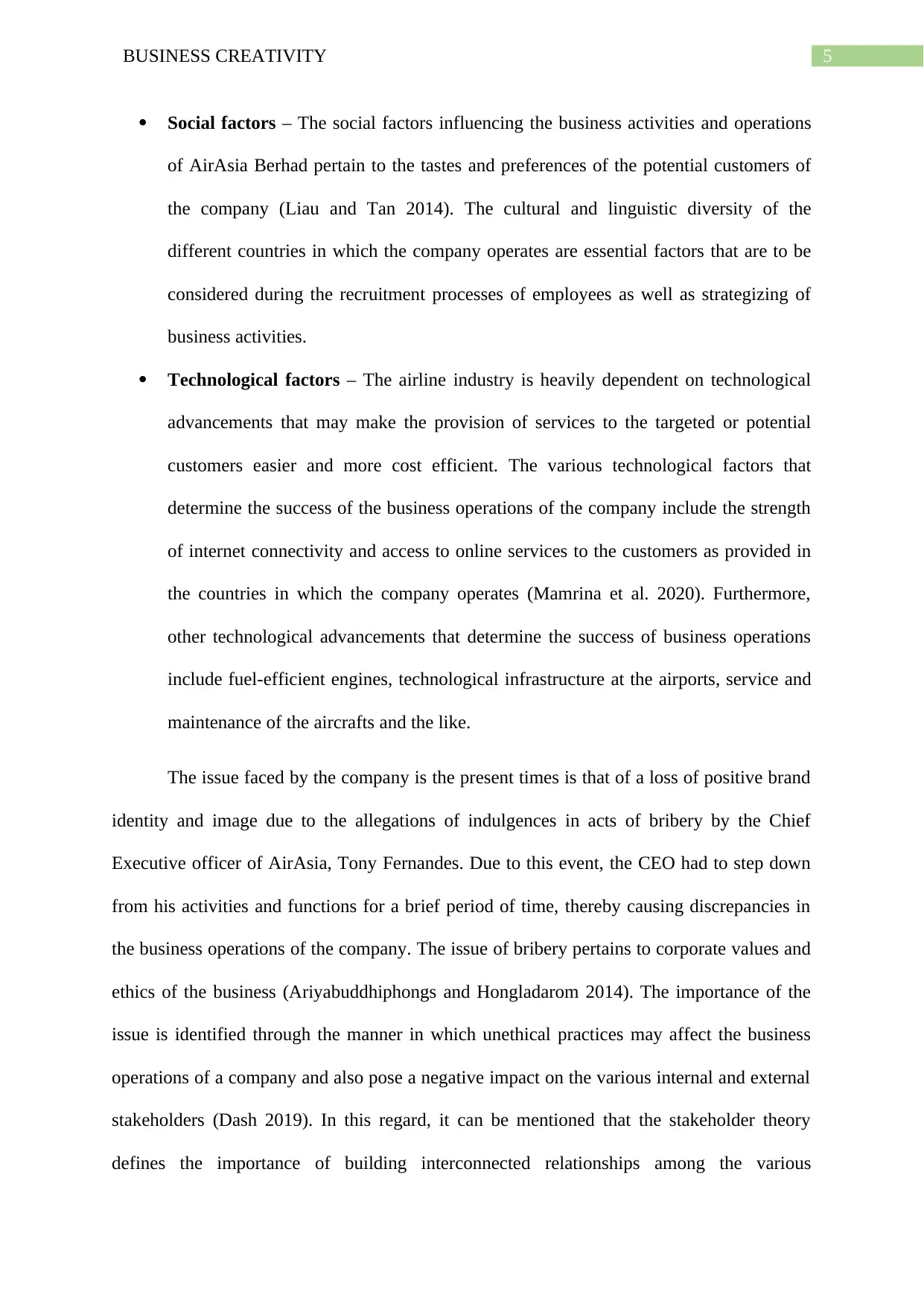
5BUSINESS CREATIVITY
Social factors – The social factors influencing the business activities and operations
of AirAsia Berhad pertain to the tastes and preferences of the potential customers of
the company (Liau and Tan 2014). The cultural and linguistic diversity of the
different countries in which the company operates are essential factors that are to be
considered during the recruitment processes of employees as well as strategizing of
business activities.
Technological factors – The airline industry is heavily dependent on technological
advancements that may make the provision of services to the targeted or potential
customers easier and more cost efficient. The various technological factors that
determine the success of the business operations of the company include the strength
of internet connectivity and access to online services to the customers as provided in
the countries in which the company operates (Mamrina et al. 2020). Furthermore,
other technological advancements that determine the success of business operations
include fuel-efficient engines, technological infrastructure at the airports, service and
maintenance of the aircrafts and the like.
The issue faced by the company is the present times is that of a loss of positive brand
identity and image due to the allegations of indulgences in acts of bribery by the Chief
Executive officer of AirAsia, Tony Fernandes. Due to this event, the CEO had to step down
from his activities and functions for a brief period of time, thereby causing discrepancies in
the business operations of the company. The issue of bribery pertains to corporate values and
ethics of the business (Ariyabuddhiphongs and Hongladarom 2014). The importance of the
issue is identified through the manner in which unethical practices may affect the business
operations of a company and also pose a negative impact on the various internal and external
stakeholders (Dash 2019). In this regard, it can be mentioned that the stakeholder theory
defines the importance of building interconnected relationships among the various
Social factors – The social factors influencing the business activities and operations
of AirAsia Berhad pertain to the tastes and preferences of the potential customers of
the company (Liau and Tan 2014). The cultural and linguistic diversity of the
different countries in which the company operates are essential factors that are to be
considered during the recruitment processes of employees as well as strategizing of
business activities.
Technological factors – The airline industry is heavily dependent on technological
advancements that may make the provision of services to the targeted or potential
customers easier and more cost efficient. The various technological factors that
determine the success of the business operations of the company include the strength
of internet connectivity and access to online services to the customers as provided in
the countries in which the company operates (Mamrina et al. 2020). Furthermore,
other technological advancements that determine the success of business operations
include fuel-efficient engines, technological infrastructure at the airports, service and
maintenance of the aircrafts and the like.
The issue faced by the company is the present times is that of a loss of positive brand
identity and image due to the allegations of indulgences in acts of bribery by the Chief
Executive officer of AirAsia, Tony Fernandes. Due to this event, the CEO had to step down
from his activities and functions for a brief period of time, thereby causing discrepancies in
the business operations of the company. The issue of bribery pertains to corporate values and
ethics of the business (Ariyabuddhiphongs and Hongladarom 2014). The importance of the
issue is identified through the manner in which unethical practices may affect the business
operations of a company and also pose a negative impact on the various internal and external
stakeholders (Dash 2019). In this regard, it can be mentioned that the stakeholder theory
defines the importance of building interconnected relationships among the various
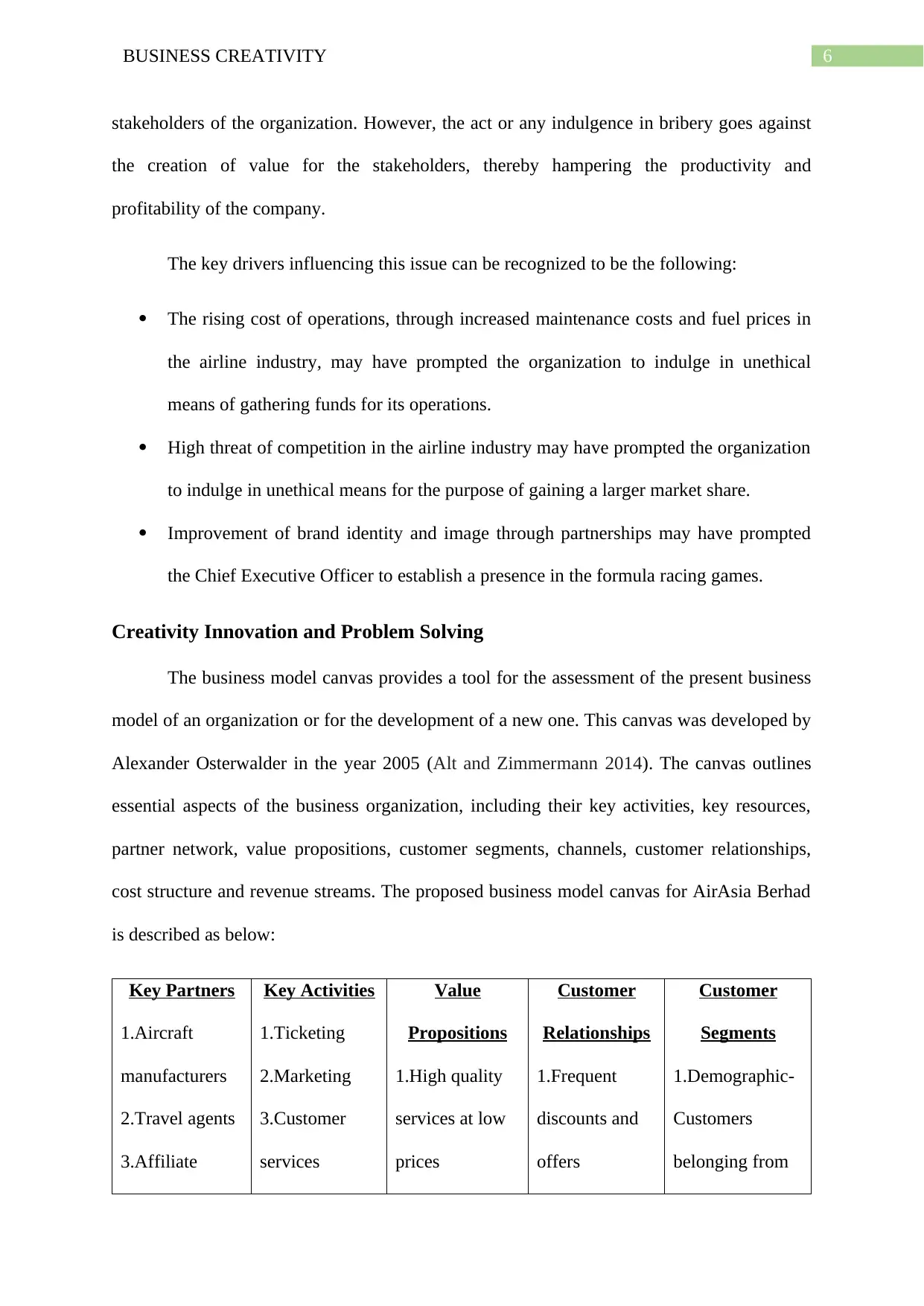
6BUSINESS CREATIVITY
stakeholders of the organization. However, the act or any indulgence in bribery goes against
the creation of value for the stakeholders, thereby hampering the productivity and
profitability of the company.
The key drivers influencing this issue can be recognized to be the following:
The rising cost of operations, through increased maintenance costs and fuel prices in
the airline industry, may have prompted the organization to indulge in unethical
means of gathering funds for its operations.
High threat of competition in the airline industry may have prompted the organization
to indulge in unethical means for the purpose of gaining a larger market share.
Improvement of brand identity and image through partnerships may have prompted
the Chief Executive Officer to establish a presence in the formula racing games.
Creativity Innovation and Problem Solving
The business model canvas provides a tool for the assessment of the present business
model of an organization or for the development of a new one. This canvas was developed by
Alexander Osterwalder in the year 2005 (Alt and Zimmermann 2014). The canvas outlines
essential aspects of the business organization, including their key activities, key resources,
partner network, value propositions, customer segments, channels, customer relationships,
cost structure and revenue streams. The proposed business model canvas for AirAsia Berhad
is described as below:
Key Partners
1.Aircraft
manufacturers
2.Travel agents
3.Affiliate
Key Activities
1.Ticketing
2.Marketing
3.Customer
services
Value
Propositions
1.High quality
services at low
prices
Customer
Relationships
1.Frequent
discounts and
offers
Customer
Segments
1.Demographic-
Customers
belonging from
stakeholders of the organization. However, the act or any indulgence in bribery goes against
the creation of value for the stakeholders, thereby hampering the productivity and
profitability of the company.
The key drivers influencing this issue can be recognized to be the following:
The rising cost of operations, through increased maintenance costs and fuel prices in
the airline industry, may have prompted the organization to indulge in unethical
means of gathering funds for its operations.
High threat of competition in the airline industry may have prompted the organization
to indulge in unethical means for the purpose of gaining a larger market share.
Improvement of brand identity and image through partnerships may have prompted
the Chief Executive Officer to establish a presence in the formula racing games.
Creativity Innovation and Problem Solving
The business model canvas provides a tool for the assessment of the present business
model of an organization or for the development of a new one. This canvas was developed by
Alexander Osterwalder in the year 2005 (Alt and Zimmermann 2014). The canvas outlines
essential aspects of the business organization, including their key activities, key resources,
partner network, value propositions, customer segments, channels, customer relationships,
cost structure and revenue streams. The proposed business model canvas for AirAsia Berhad
is described as below:
Key Partners
1.Aircraft
manufacturers
2.Travel agents
3.Affiliate
Key Activities
1.Ticketing
2.Marketing
3.Customer
services
Value
Propositions
1.High quality
services at low
prices
Customer
Relationships
1.Frequent
discounts and
offers
Customer
Segments
1.Demographic-
Customers
belonging from
Paraphrase This Document
Need a fresh take? Get an instant paraphrase of this document with our AI Paraphraser
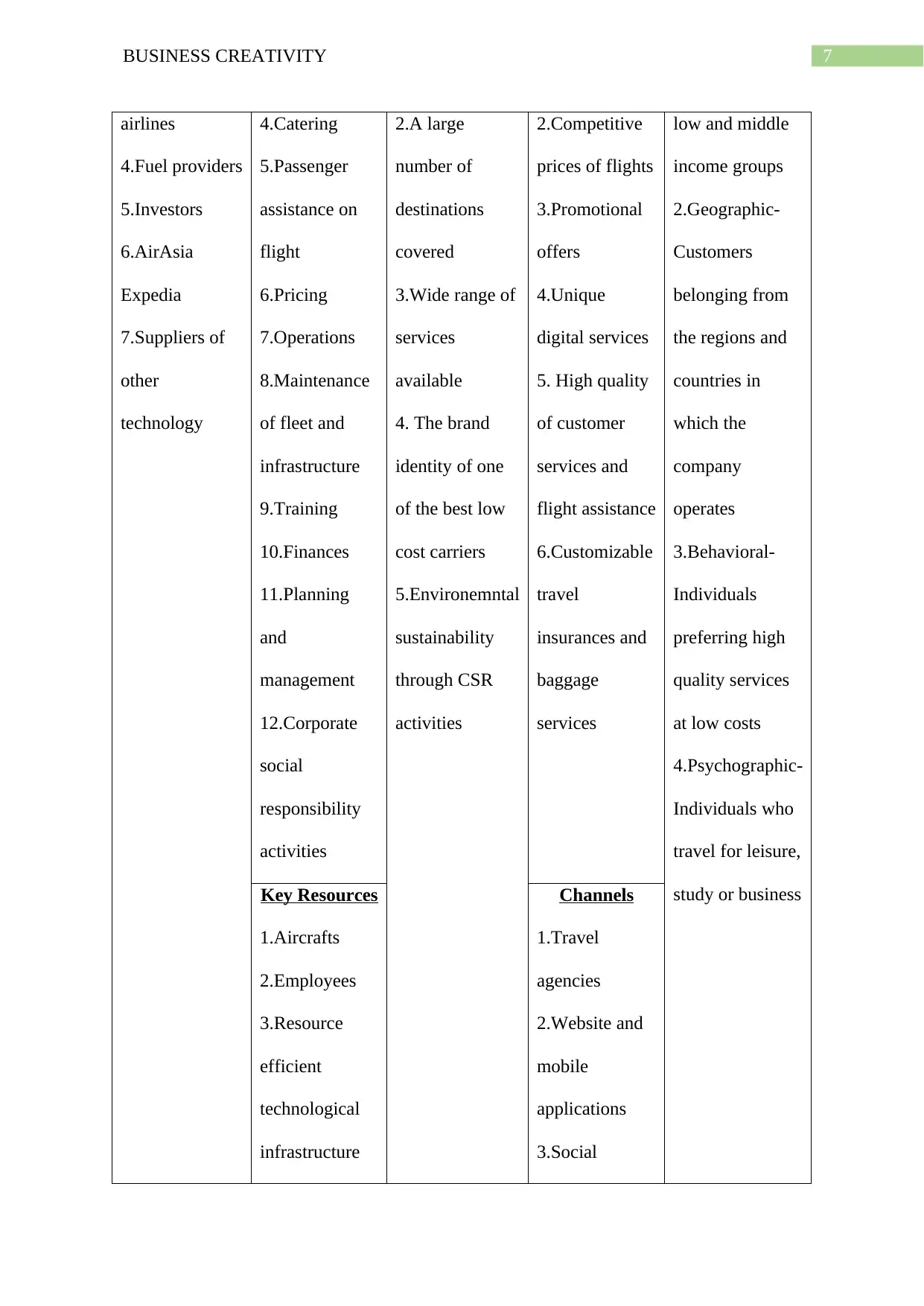
7BUSINESS CREATIVITY
airlines
4.Fuel providers
5.Investors
6.AirAsia
Expedia
7.Suppliers of
other
technology
4.Catering
5.Passenger
assistance on
flight
6.Pricing
7.Operations
8.Maintenance
of fleet and
infrastructure
9.Training
10.Finances
11.Planning
and
management
12.Corporate
social
responsibility
activities
2.A large
number of
destinations
covered
3.Wide range of
services
available
4. The brand
identity of one
of the best low
cost carriers
5.Environemntal
sustainability
through CSR
activities
2.Competitive
prices of flights
3.Promotional
offers
4.Unique
digital services
5. High quality
of customer
services and
flight assistance
6.Customizable
travel
insurances and
baggage
services
low and middle
income groups
2.Geographic-
Customers
belonging from
the regions and
countries in
which the
company
operates
3.Behavioral-
Individuals
preferring high
quality services
at low costs
4.Psychographic-
Individuals who
travel for leisure,
study or businessKey Resources
1.Aircrafts
2.Employees
3.Resource
efficient
technological
infrastructure
Channels
1.Travel
agencies
2.Website and
mobile
applications
3.Social
airlines
4.Fuel providers
5.Investors
6.AirAsia
Expedia
7.Suppliers of
other
technology
4.Catering
5.Passenger
assistance on
flight
6.Pricing
7.Operations
8.Maintenance
of fleet and
infrastructure
9.Training
10.Finances
11.Planning
and
management
12.Corporate
social
responsibility
activities
2.A large
number of
destinations
covered
3.Wide range of
services
available
4. The brand
identity of one
of the best low
cost carriers
5.Environemntal
sustainability
through CSR
activities
2.Competitive
prices of flights
3.Promotional
offers
4.Unique
digital services
5. High quality
of customer
services and
flight assistance
6.Customizable
travel
insurances and
baggage
services
low and middle
income groups
2.Geographic-
Customers
belonging from
the regions and
countries in
which the
company
operates
3.Behavioral-
Individuals
preferring high
quality services
at low costs
4.Psychographic-
Individuals who
travel for leisure,
study or businessKey Resources
1.Aircrafts
2.Employees
3.Resource
efficient
technological
infrastructure
Channels
1.Travel
agencies
2.Website and
mobile
applications
3.Social
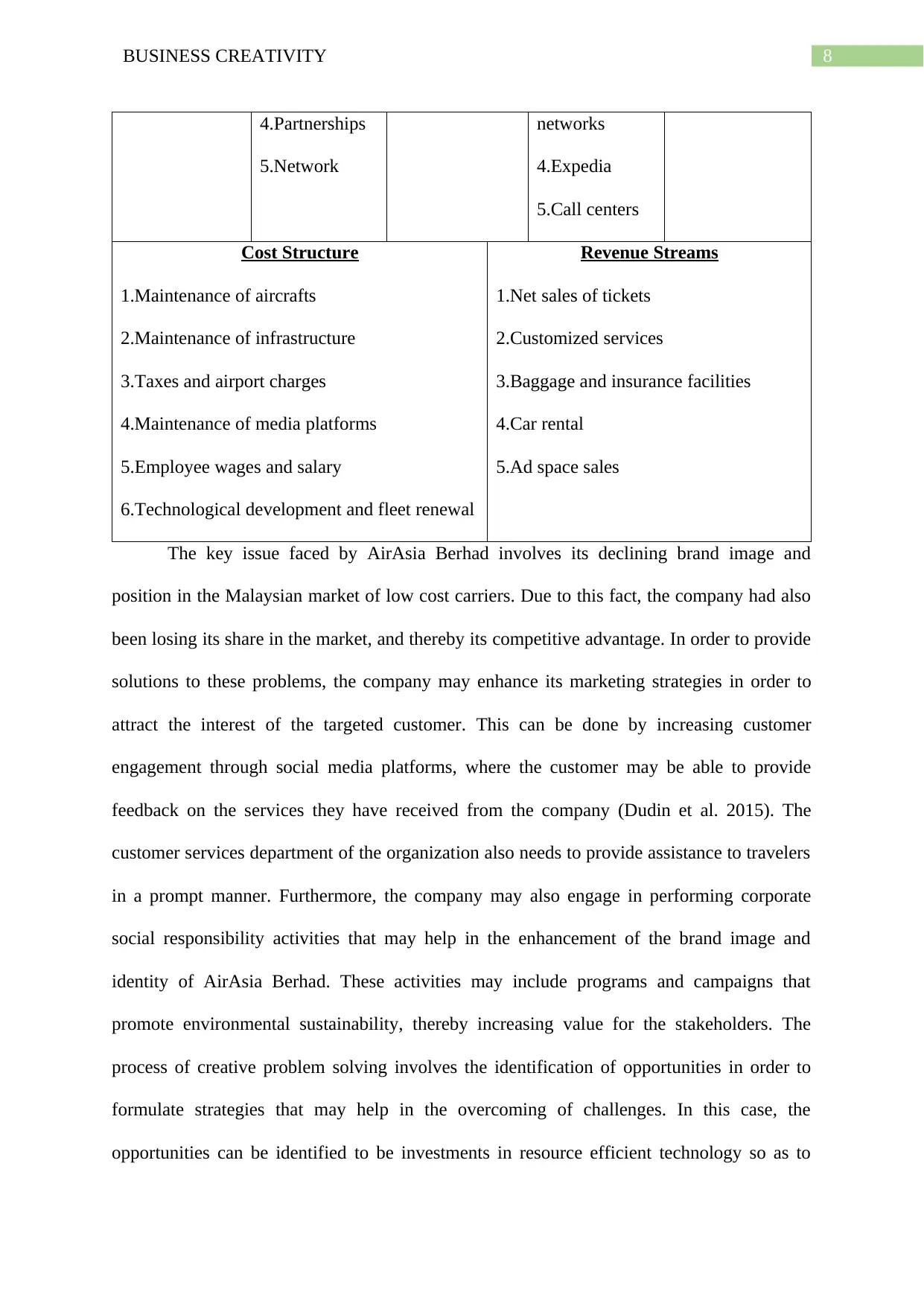
8BUSINESS CREATIVITY
4.Partnerships
5.Network
networks
4.Expedia
5.Call centers
Cost Structure
1.Maintenance of aircrafts
2.Maintenance of infrastructure
3.Taxes and airport charges
4.Maintenance of media platforms
5.Employee wages and salary
6.Technological development and fleet renewal
Revenue Streams
1.Net sales of tickets
2.Customized services
3.Baggage and insurance facilities
4.Car rental
5.Ad space sales
The key issue faced by AirAsia Berhad involves its declining brand image and
position in the Malaysian market of low cost carriers. Due to this fact, the company had also
been losing its share in the market, and thereby its competitive advantage. In order to provide
solutions to these problems, the company may enhance its marketing strategies in order to
attract the interest of the targeted customer. This can be done by increasing customer
engagement through social media platforms, where the customer may be able to provide
feedback on the services they have received from the company (Dudin et al. 2015). The
customer services department of the organization also needs to provide assistance to travelers
in a prompt manner. Furthermore, the company may also engage in performing corporate
social responsibility activities that may help in the enhancement of the brand image and
identity of AirAsia Berhad. These activities may include programs and campaigns that
promote environmental sustainability, thereby increasing value for the stakeholders. The
process of creative problem solving involves the identification of opportunities in order to
formulate strategies that may help in the overcoming of challenges. In this case, the
opportunities can be identified to be investments in resource efficient technology so as to
4.Partnerships
5.Network
networks
4.Expedia
5.Call centers
Cost Structure
1.Maintenance of aircrafts
2.Maintenance of infrastructure
3.Taxes and airport charges
4.Maintenance of media platforms
5.Employee wages and salary
6.Technological development and fleet renewal
Revenue Streams
1.Net sales of tickets
2.Customized services
3.Baggage and insurance facilities
4.Car rental
5.Ad space sales
The key issue faced by AirAsia Berhad involves its declining brand image and
position in the Malaysian market of low cost carriers. Due to this fact, the company had also
been losing its share in the market, and thereby its competitive advantage. In order to provide
solutions to these problems, the company may enhance its marketing strategies in order to
attract the interest of the targeted customer. This can be done by increasing customer
engagement through social media platforms, where the customer may be able to provide
feedback on the services they have received from the company (Dudin et al. 2015). The
customer services department of the organization also needs to provide assistance to travelers
in a prompt manner. Furthermore, the company may also engage in performing corporate
social responsibility activities that may help in the enhancement of the brand image and
identity of AirAsia Berhad. These activities may include programs and campaigns that
promote environmental sustainability, thereby increasing value for the stakeholders. The
process of creative problem solving involves the identification of opportunities in order to
formulate strategies that may help in the overcoming of challenges. In this case, the
opportunities can be identified to be investments in resource efficient technology so as to
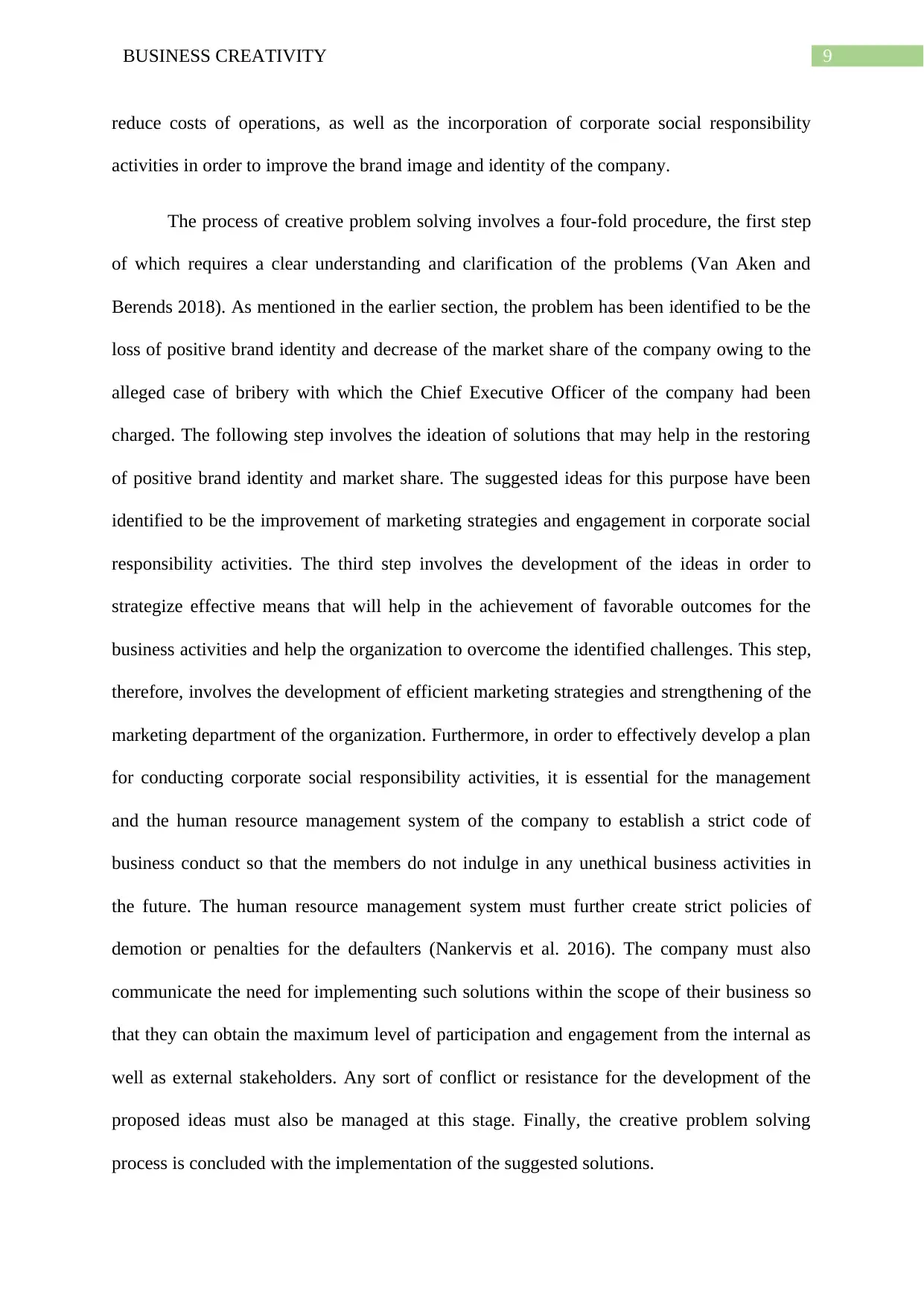
9BUSINESS CREATIVITY
reduce costs of operations, as well as the incorporation of corporate social responsibility
activities in order to improve the brand image and identity of the company.
The process of creative problem solving involves a four-fold procedure, the first step
of which requires a clear understanding and clarification of the problems (Van Aken and
Berends 2018). As mentioned in the earlier section, the problem has been identified to be the
loss of positive brand identity and decrease of the market share of the company owing to the
alleged case of bribery with which the Chief Executive Officer of the company had been
charged. The following step involves the ideation of solutions that may help in the restoring
of positive brand identity and market share. The suggested ideas for this purpose have been
identified to be the improvement of marketing strategies and engagement in corporate social
responsibility activities. The third step involves the development of the ideas in order to
strategize effective means that will help in the achievement of favorable outcomes for the
business activities and help the organization to overcome the identified challenges. This step,
therefore, involves the development of efficient marketing strategies and strengthening of the
marketing department of the organization. Furthermore, in order to effectively develop a plan
for conducting corporate social responsibility activities, it is essential for the management
and the human resource management system of the company to establish a strict code of
business conduct so that the members do not indulge in any unethical business activities in
the future. The human resource management system must further create strict policies of
demotion or penalties for the defaulters (Nankervis et al. 2016). The company must also
communicate the need for implementing such solutions within the scope of their business so
that they can obtain the maximum level of participation and engagement from the internal as
well as external stakeholders. Any sort of conflict or resistance for the development of the
proposed ideas must also be managed at this stage. Finally, the creative problem solving
process is concluded with the implementation of the suggested solutions.
reduce costs of operations, as well as the incorporation of corporate social responsibility
activities in order to improve the brand image and identity of the company.
The process of creative problem solving involves a four-fold procedure, the first step
of which requires a clear understanding and clarification of the problems (Van Aken and
Berends 2018). As mentioned in the earlier section, the problem has been identified to be the
loss of positive brand identity and decrease of the market share of the company owing to the
alleged case of bribery with which the Chief Executive Officer of the company had been
charged. The following step involves the ideation of solutions that may help in the restoring
of positive brand identity and market share. The suggested ideas for this purpose have been
identified to be the improvement of marketing strategies and engagement in corporate social
responsibility activities. The third step involves the development of the ideas in order to
strategize effective means that will help in the achievement of favorable outcomes for the
business activities and help the organization to overcome the identified challenges. This step,
therefore, involves the development of efficient marketing strategies and strengthening of the
marketing department of the organization. Furthermore, in order to effectively develop a plan
for conducting corporate social responsibility activities, it is essential for the management
and the human resource management system of the company to establish a strict code of
business conduct so that the members do not indulge in any unethical business activities in
the future. The human resource management system must further create strict policies of
demotion or penalties for the defaulters (Nankervis et al. 2016). The company must also
communicate the need for implementing such solutions within the scope of their business so
that they can obtain the maximum level of participation and engagement from the internal as
well as external stakeholders. Any sort of conflict or resistance for the development of the
proposed ideas must also be managed at this stage. Finally, the creative problem solving
process is concluded with the implementation of the suggested solutions.
Secure Best Marks with AI Grader
Need help grading? Try our AI Grader for instant feedback on your assignments.
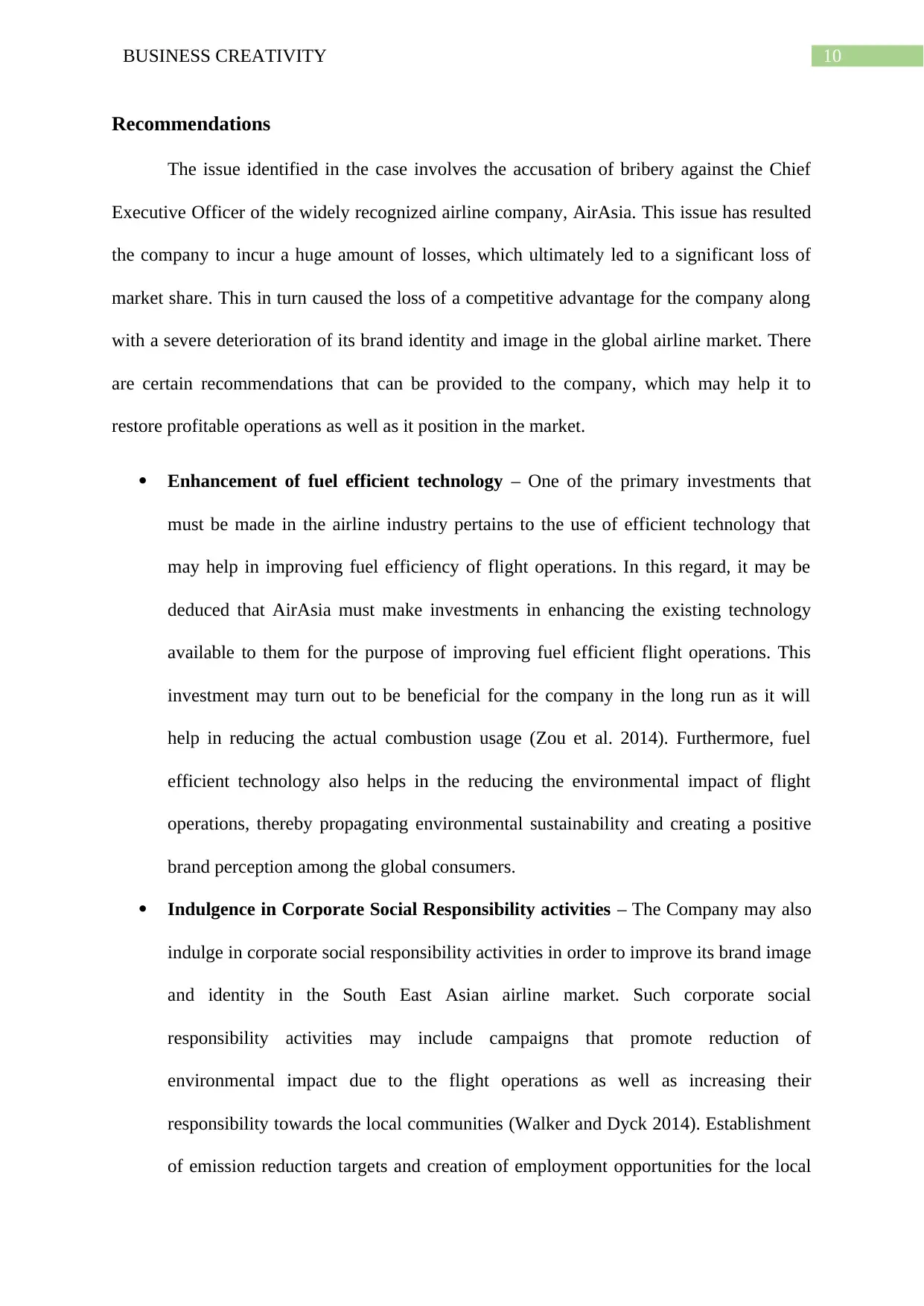
10BUSINESS CREATIVITY
Recommendations
The issue identified in the case involves the accusation of bribery against the Chief
Executive Officer of the widely recognized airline company, AirAsia. This issue has resulted
the company to incur a huge amount of losses, which ultimately led to a significant loss of
market share. This in turn caused the loss of a competitive advantage for the company along
with a severe deterioration of its brand identity and image in the global airline market. There
are certain recommendations that can be provided to the company, which may help it to
restore profitable operations as well as it position in the market.
Enhancement of fuel efficient technology – One of the primary investments that
must be made in the airline industry pertains to the use of efficient technology that
may help in improving fuel efficiency of flight operations. In this regard, it may be
deduced that AirAsia must make investments in enhancing the existing technology
available to them for the purpose of improving fuel efficient flight operations. This
investment may turn out to be beneficial for the company in the long run as it will
help in reducing the actual combustion usage (Zou et al. 2014). Furthermore, fuel
efficient technology also helps in the reducing the environmental impact of flight
operations, thereby propagating environmental sustainability and creating a positive
brand perception among the global consumers.
Indulgence in Corporate Social Responsibility activities – The Company may also
indulge in corporate social responsibility activities in order to improve its brand image
and identity in the South East Asian airline market. Such corporate social
responsibility activities may include campaigns that promote reduction of
environmental impact due to the flight operations as well as increasing their
responsibility towards the local communities (Walker and Dyck 2014). Establishment
of emission reduction targets and creation of employment opportunities for the local
Recommendations
The issue identified in the case involves the accusation of bribery against the Chief
Executive Officer of the widely recognized airline company, AirAsia. This issue has resulted
the company to incur a huge amount of losses, which ultimately led to a significant loss of
market share. This in turn caused the loss of a competitive advantage for the company along
with a severe deterioration of its brand identity and image in the global airline market. There
are certain recommendations that can be provided to the company, which may help it to
restore profitable operations as well as it position in the market.
Enhancement of fuel efficient technology – One of the primary investments that
must be made in the airline industry pertains to the use of efficient technology that
may help in improving fuel efficiency of flight operations. In this regard, it may be
deduced that AirAsia must make investments in enhancing the existing technology
available to them for the purpose of improving fuel efficient flight operations. This
investment may turn out to be beneficial for the company in the long run as it will
help in reducing the actual combustion usage (Zou et al. 2014). Furthermore, fuel
efficient technology also helps in the reducing the environmental impact of flight
operations, thereby propagating environmental sustainability and creating a positive
brand perception among the global consumers.
Indulgence in Corporate Social Responsibility activities – The Company may also
indulge in corporate social responsibility activities in order to improve its brand image
and identity in the South East Asian airline market. Such corporate social
responsibility activities may include campaigns that promote reduction of
environmental impact due to the flight operations as well as increasing their
responsibility towards the local communities (Walker and Dyck 2014). Establishment
of emission reduction targets and creation of employment opportunities for the local
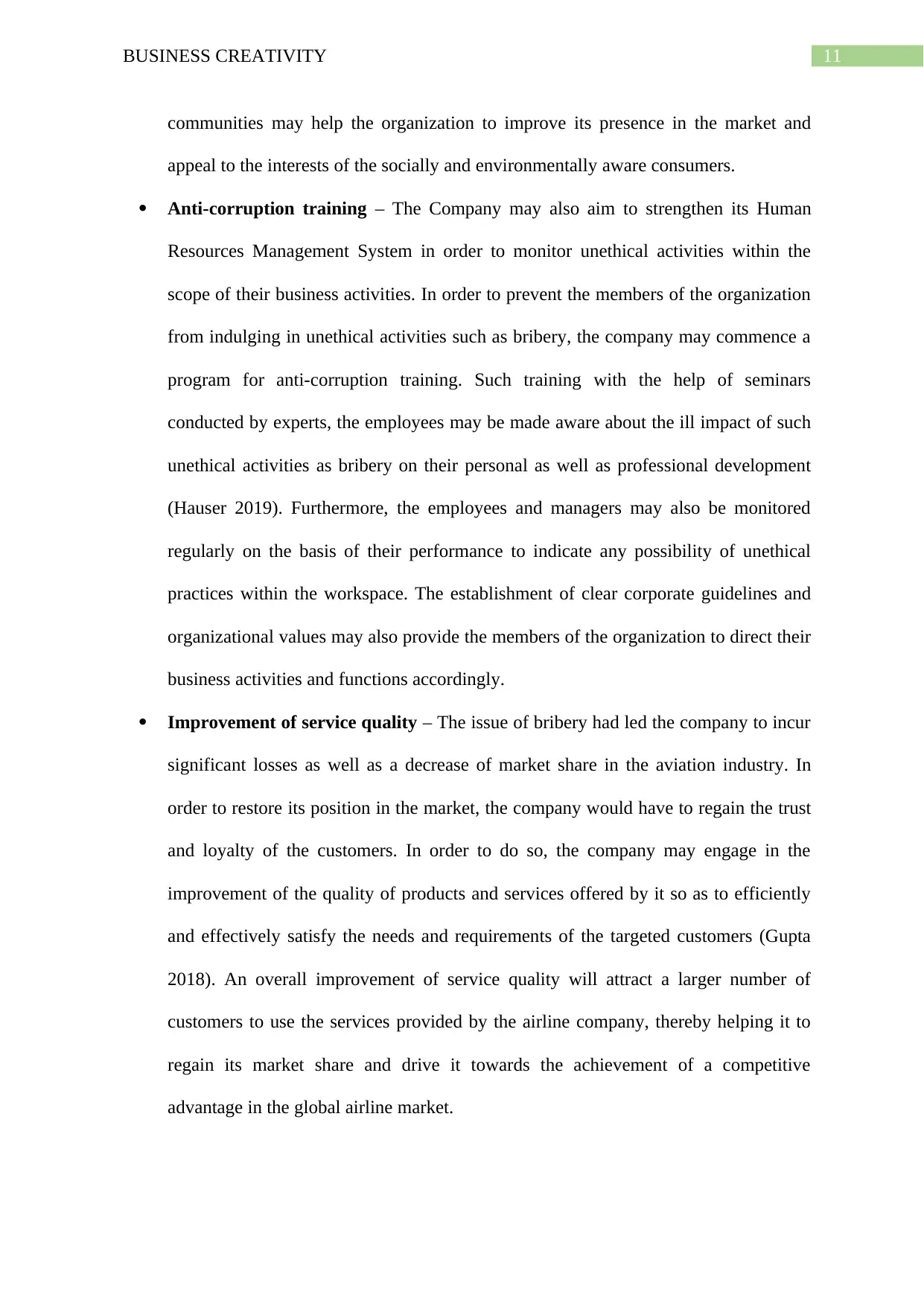
11BUSINESS CREATIVITY
communities may help the organization to improve its presence in the market and
appeal to the interests of the socially and environmentally aware consumers.
Anti-corruption training – The Company may also aim to strengthen its Human
Resources Management System in order to monitor unethical activities within the
scope of their business activities. In order to prevent the members of the organization
from indulging in unethical activities such as bribery, the company may commence a
program for anti-corruption training. Such training with the help of seminars
conducted by experts, the employees may be made aware about the ill impact of such
unethical activities as bribery on their personal as well as professional development
(Hauser 2019). Furthermore, the employees and managers may also be monitored
regularly on the basis of their performance to indicate any possibility of unethical
practices within the workspace. The establishment of clear corporate guidelines and
organizational values may also provide the members of the organization to direct their
business activities and functions accordingly.
Improvement of service quality – The issue of bribery had led the company to incur
significant losses as well as a decrease of market share in the aviation industry. In
order to restore its position in the market, the company would have to regain the trust
and loyalty of the customers. In order to do so, the company may engage in the
improvement of the quality of products and services offered by it so as to efficiently
and effectively satisfy the needs and requirements of the targeted customers (Gupta
2018). An overall improvement of service quality will attract a larger number of
customers to use the services provided by the airline company, thereby helping it to
regain its market share and drive it towards the achievement of a competitive
advantage in the global airline market.
communities may help the organization to improve its presence in the market and
appeal to the interests of the socially and environmentally aware consumers.
Anti-corruption training – The Company may also aim to strengthen its Human
Resources Management System in order to monitor unethical activities within the
scope of their business activities. In order to prevent the members of the organization
from indulging in unethical activities such as bribery, the company may commence a
program for anti-corruption training. Such training with the help of seminars
conducted by experts, the employees may be made aware about the ill impact of such
unethical activities as bribery on their personal as well as professional development
(Hauser 2019). Furthermore, the employees and managers may also be monitored
regularly on the basis of their performance to indicate any possibility of unethical
practices within the workspace. The establishment of clear corporate guidelines and
organizational values may also provide the members of the organization to direct their
business activities and functions accordingly.
Improvement of service quality – The issue of bribery had led the company to incur
significant losses as well as a decrease of market share in the aviation industry. In
order to restore its position in the market, the company would have to regain the trust
and loyalty of the customers. In order to do so, the company may engage in the
improvement of the quality of products and services offered by it so as to efficiently
and effectively satisfy the needs and requirements of the targeted customers (Gupta
2018). An overall improvement of service quality will attract a larger number of
customers to use the services provided by the airline company, thereby helping it to
regain its market share and drive it towards the achievement of a competitive
advantage in the global airline market.
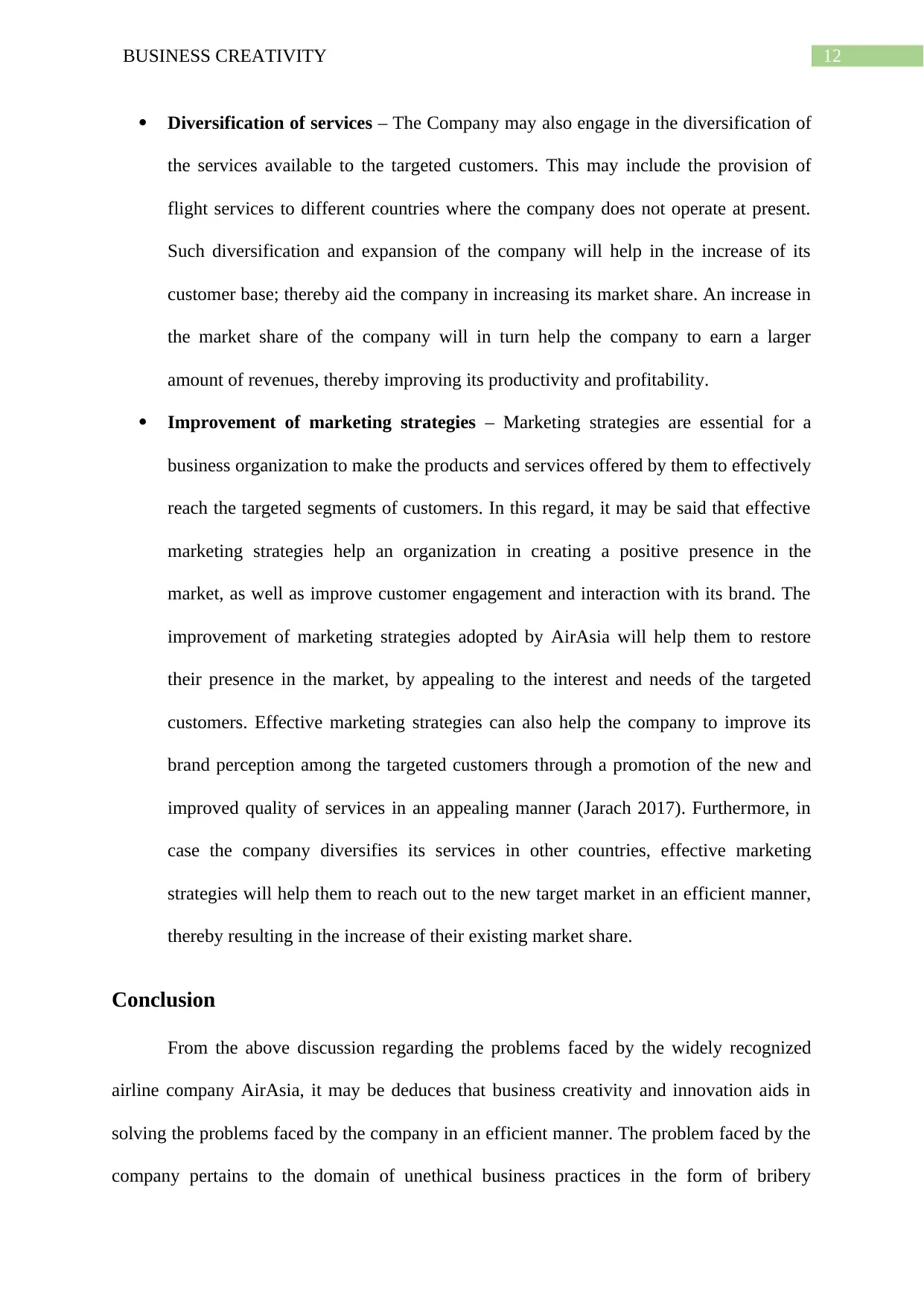
12BUSINESS CREATIVITY
Diversification of services – The Company may also engage in the diversification of
the services available to the targeted customers. This may include the provision of
flight services to different countries where the company does not operate at present.
Such diversification and expansion of the company will help in the increase of its
customer base; thereby aid the company in increasing its market share. An increase in
the market share of the company will in turn help the company to earn a larger
amount of revenues, thereby improving its productivity and profitability.
Improvement of marketing strategies – Marketing strategies are essential for a
business organization to make the products and services offered by them to effectively
reach the targeted segments of customers. In this regard, it may be said that effective
marketing strategies help an organization in creating a positive presence in the
market, as well as improve customer engagement and interaction with its brand. The
improvement of marketing strategies adopted by AirAsia will help them to restore
their presence in the market, by appealing to the interest and needs of the targeted
customers. Effective marketing strategies can also help the company to improve its
brand perception among the targeted customers through a promotion of the new and
improved quality of services in an appealing manner (Jarach 2017). Furthermore, in
case the company diversifies its services in other countries, effective marketing
strategies will help them to reach out to the new target market in an efficient manner,
thereby resulting in the increase of their existing market share.
Conclusion
From the above discussion regarding the problems faced by the widely recognized
airline company AirAsia, it may be deduces that business creativity and innovation aids in
solving the problems faced by the company in an efficient manner. The problem faced by the
company pertains to the domain of unethical business practices in the form of bribery
Diversification of services – The Company may also engage in the diversification of
the services available to the targeted customers. This may include the provision of
flight services to different countries where the company does not operate at present.
Such diversification and expansion of the company will help in the increase of its
customer base; thereby aid the company in increasing its market share. An increase in
the market share of the company will in turn help the company to earn a larger
amount of revenues, thereby improving its productivity and profitability.
Improvement of marketing strategies – Marketing strategies are essential for a
business organization to make the products and services offered by them to effectively
reach the targeted segments of customers. In this regard, it may be said that effective
marketing strategies help an organization in creating a positive presence in the
market, as well as improve customer engagement and interaction with its brand. The
improvement of marketing strategies adopted by AirAsia will help them to restore
their presence in the market, by appealing to the interest and needs of the targeted
customers. Effective marketing strategies can also help the company to improve its
brand perception among the targeted customers through a promotion of the new and
improved quality of services in an appealing manner (Jarach 2017). Furthermore, in
case the company diversifies its services in other countries, effective marketing
strategies will help them to reach out to the new target market in an efficient manner,
thereby resulting in the increase of their existing market share.
Conclusion
From the above discussion regarding the problems faced by the widely recognized
airline company AirAsia, it may be deduces that business creativity and innovation aids in
solving the problems faced by the company in an efficient manner. The problem faced by the
company pertains to the domain of unethical business practices in the form of bribery
Paraphrase This Document
Need a fresh take? Get an instant paraphrase of this document with our AI Paraphraser
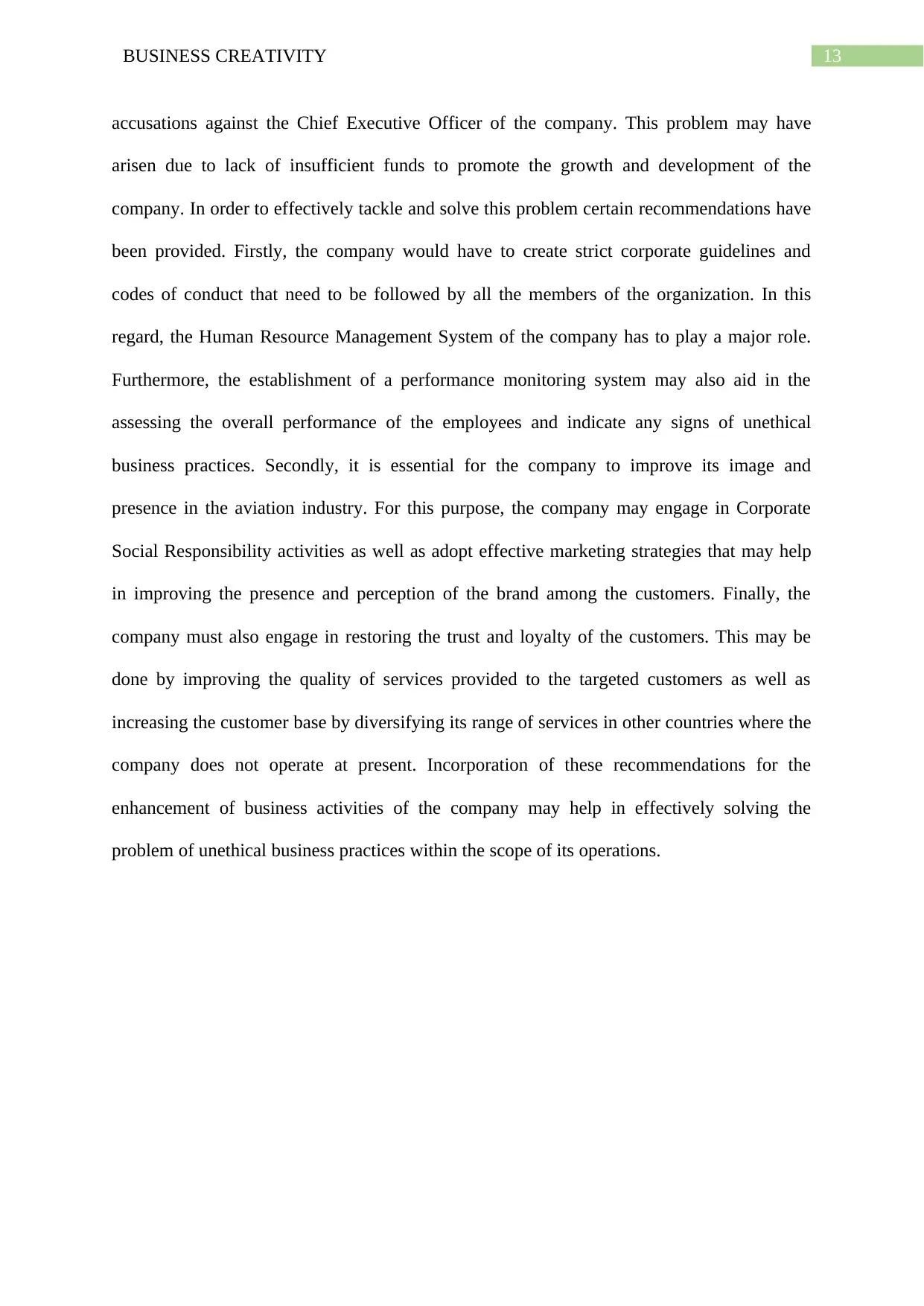
13BUSINESS CREATIVITY
accusations against the Chief Executive Officer of the company. This problem may have
arisen due to lack of insufficient funds to promote the growth and development of the
company. In order to effectively tackle and solve this problem certain recommendations have
been provided. Firstly, the company would have to create strict corporate guidelines and
codes of conduct that need to be followed by all the members of the organization. In this
regard, the Human Resource Management System of the company has to play a major role.
Furthermore, the establishment of a performance monitoring system may also aid in the
assessing the overall performance of the employees and indicate any signs of unethical
business practices. Secondly, it is essential for the company to improve its image and
presence in the aviation industry. For this purpose, the company may engage in Corporate
Social Responsibility activities as well as adopt effective marketing strategies that may help
in improving the presence and perception of the brand among the customers. Finally, the
company must also engage in restoring the trust and loyalty of the customers. This may be
done by improving the quality of services provided to the targeted customers as well as
increasing the customer base by diversifying its range of services in other countries where the
company does not operate at present. Incorporation of these recommendations for the
enhancement of business activities of the company may help in effectively solving the
problem of unethical business practices within the scope of its operations.
accusations against the Chief Executive Officer of the company. This problem may have
arisen due to lack of insufficient funds to promote the growth and development of the
company. In order to effectively tackle and solve this problem certain recommendations have
been provided. Firstly, the company would have to create strict corporate guidelines and
codes of conduct that need to be followed by all the members of the organization. In this
regard, the Human Resource Management System of the company has to play a major role.
Furthermore, the establishment of a performance monitoring system may also aid in the
assessing the overall performance of the employees and indicate any signs of unethical
business practices. Secondly, it is essential for the company to improve its image and
presence in the aviation industry. For this purpose, the company may engage in Corporate
Social Responsibility activities as well as adopt effective marketing strategies that may help
in improving the presence and perception of the brand among the customers. Finally, the
company must also engage in restoring the trust and loyalty of the customers. This may be
done by improving the quality of services provided to the targeted customers as well as
increasing the customer base by diversifying its range of services in other countries where the
company does not operate at present. Incorporation of these recommendations for the
enhancement of business activities of the company may help in effectively solving the
problem of unethical business practices within the scope of its operations.
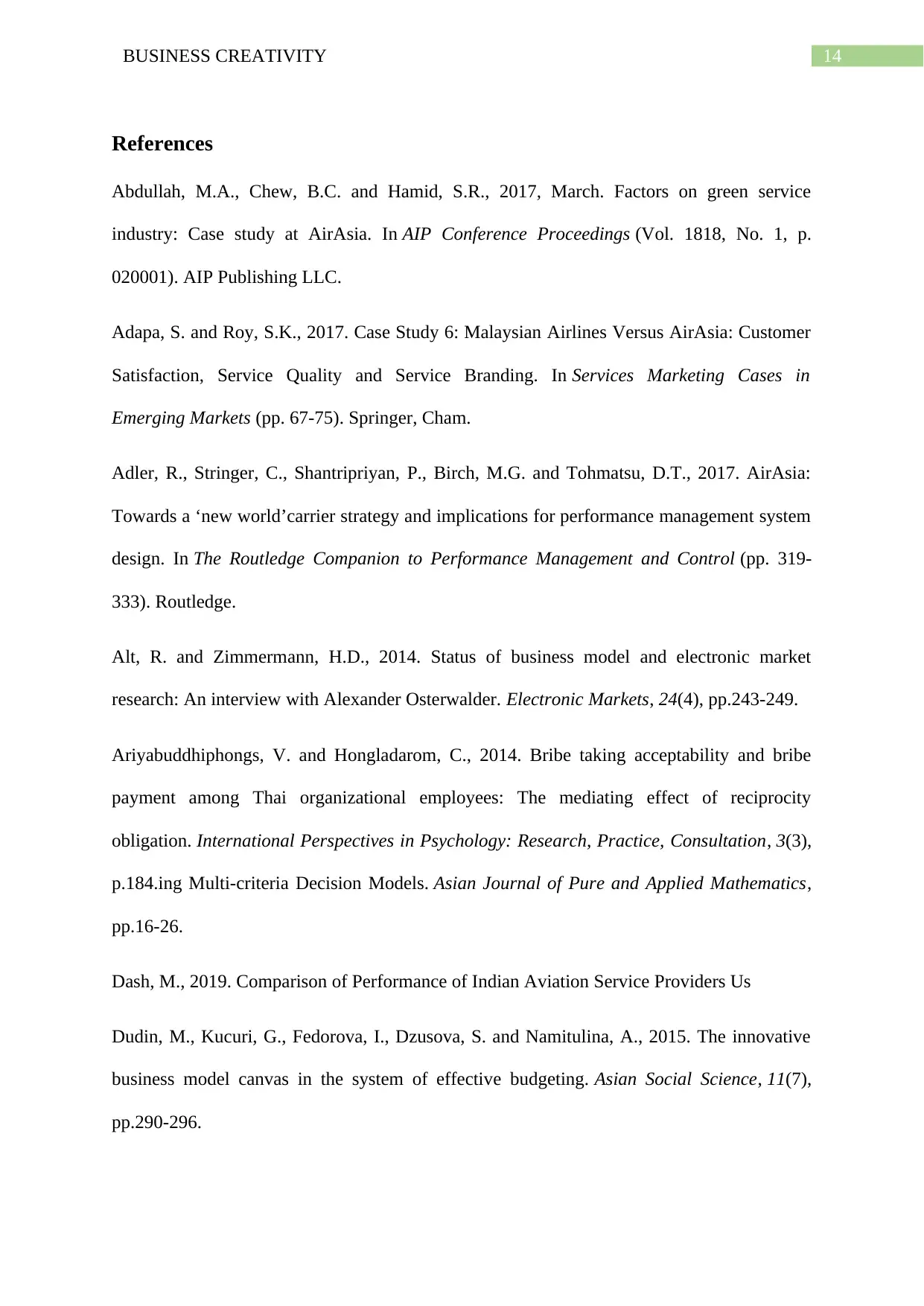
14BUSINESS CREATIVITY
References
Abdullah, M.A., Chew, B.C. and Hamid, S.R., 2017, March. Factors on green service
industry: Case study at AirAsia. In AIP Conference Proceedings (Vol. 1818, No. 1, p.
020001). AIP Publishing LLC.
Adapa, S. and Roy, S.K., 2017. Case Study 6: Malaysian Airlines Versus AirAsia: Customer
Satisfaction, Service Quality and Service Branding. In Services Marketing Cases in
Emerging Markets (pp. 67-75). Springer, Cham.
Adler, R., Stringer, C., Shantripriyan, P., Birch, M.G. and Tohmatsu, D.T., 2017. AirAsia:
Towards a ‘new world’carrier strategy and implications for performance management system
design. In The Routledge Companion to Performance Management and Control (pp. 319-
333). Routledge.
Alt, R. and Zimmermann, H.D., 2014. Status of business model and electronic market
research: An interview with Alexander Osterwalder. Electronic Markets, 24(4), pp.243-249.
Ariyabuddhiphongs, V. and Hongladarom, C., 2014. Bribe taking acceptability and bribe
payment among Thai organizational employees: The mediating effect of reciprocity
obligation. International Perspectives in Psychology: Research, Practice, Consultation, 3(3),
p.184.ing Multi-criteria Decision Models. Asian Journal of Pure and Applied Mathematics,
pp.16-26.
Dash, M., 2019. Comparison of Performance of Indian Aviation Service Providers Us
Dudin, M., Kucuri, G., Fedorova, I., Dzusova, S. and Namitulina, A., 2015. The innovative
business model canvas in the system of effective budgeting. Asian Social Science, 11(7),
pp.290-296.
References
Abdullah, M.A., Chew, B.C. and Hamid, S.R., 2017, March. Factors on green service
industry: Case study at AirAsia. In AIP Conference Proceedings (Vol. 1818, No. 1, p.
020001). AIP Publishing LLC.
Adapa, S. and Roy, S.K., 2017. Case Study 6: Malaysian Airlines Versus AirAsia: Customer
Satisfaction, Service Quality and Service Branding. In Services Marketing Cases in
Emerging Markets (pp. 67-75). Springer, Cham.
Adler, R., Stringer, C., Shantripriyan, P., Birch, M.G. and Tohmatsu, D.T., 2017. AirAsia:
Towards a ‘new world’carrier strategy and implications for performance management system
design. In The Routledge Companion to Performance Management and Control (pp. 319-
333). Routledge.
Alt, R. and Zimmermann, H.D., 2014. Status of business model and electronic market
research: An interview with Alexander Osterwalder. Electronic Markets, 24(4), pp.243-249.
Ariyabuddhiphongs, V. and Hongladarom, C., 2014. Bribe taking acceptability and bribe
payment among Thai organizational employees: The mediating effect of reciprocity
obligation. International Perspectives in Psychology: Research, Practice, Consultation, 3(3),
p.184.ing Multi-criteria Decision Models. Asian Journal of Pure and Applied Mathematics,
pp.16-26.
Dash, M., 2019. Comparison of Performance of Indian Aviation Service Providers Us
Dudin, M., Kucuri, G., Fedorova, I., Dzusova, S. and Namitulina, A., 2015. The innovative
business model canvas in the system of effective budgeting. Asian Social Science, 11(7),
pp.290-296.
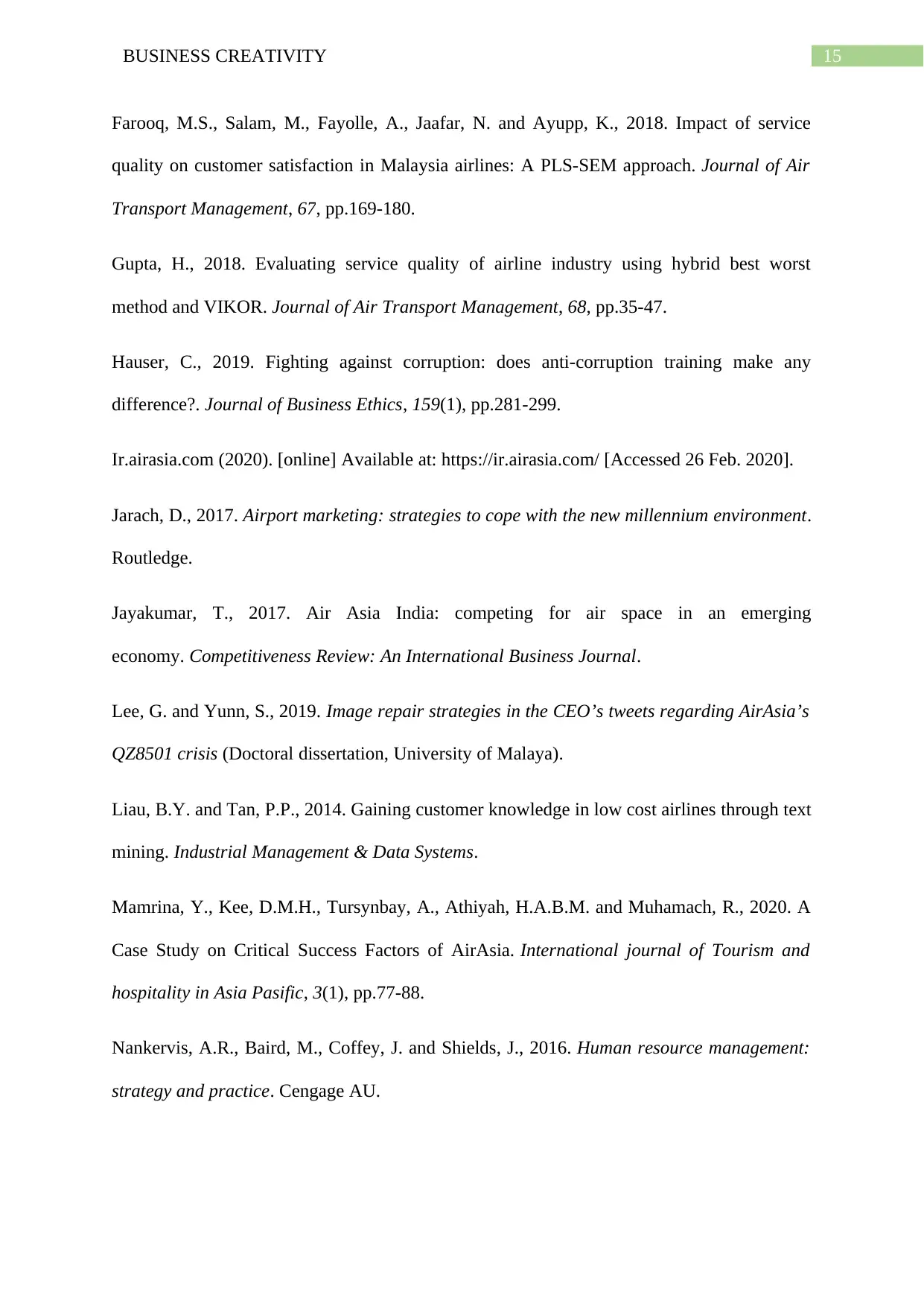
15BUSINESS CREATIVITY
Farooq, M.S., Salam, M., Fayolle, A., Jaafar, N. and Ayupp, K., 2018. Impact of service
quality on customer satisfaction in Malaysia airlines: A PLS-SEM approach. Journal of Air
Transport Management, 67, pp.169-180.
Gupta, H., 2018. Evaluating service quality of airline industry using hybrid best worst
method and VIKOR. Journal of Air Transport Management, 68, pp.35-47.
Hauser, C., 2019. Fighting against corruption: does anti-corruption training make any
difference?. Journal of Business Ethics, 159(1), pp.281-299.
Ir.airasia.com (2020). [online] Available at: https://ir.airasia.com/ [Accessed 26 Feb. 2020].
Jarach, D., 2017. Airport marketing: strategies to cope with the new millennium environment.
Routledge.
Jayakumar, T., 2017. Air Asia India: competing for air space in an emerging
economy. Competitiveness Review: An International Business Journal.
Lee, G. and Yunn, S., 2019. Image repair strategies in the CEO’s tweets regarding AirAsia’s
QZ8501 crisis (Doctoral dissertation, University of Malaya).
Liau, B.Y. and Tan, P.P., 2014. Gaining customer knowledge in low cost airlines through text
mining. Industrial Management & Data Systems.
Mamrina, Y., Kee, D.M.H., Tursynbay, A., Athiyah, H.A.B.M. and Muhamach, R., 2020. A
Case Study on Critical Success Factors of AirAsia. International journal of Tourism and
hospitality in Asia Pasific, 3(1), pp.77-88.
Nankervis, A.R., Baird, M., Coffey, J. and Shields, J., 2016. Human resource management:
strategy and practice. Cengage AU.
Farooq, M.S., Salam, M., Fayolle, A., Jaafar, N. and Ayupp, K., 2018. Impact of service
quality on customer satisfaction in Malaysia airlines: A PLS-SEM approach. Journal of Air
Transport Management, 67, pp.169-180.
Gupta, H., 2018. Evaluating service quality of airline industry using hybrid best worst
method and VIKOR. Journal of Air Transport Management, 68, pp.35-47.
Hauser, C., 2019. Fighting against corruption: does anti-corruption training make any
difference?. Journal of Business Ethics, 159(1), pp.281-299.
Ir.airasia.com (2020). [online] Available at: https://ir.airasia.com/ [Accessed 26 Feb. 2020].
Jarach, D., 2017. Airport marketing: strategies to cope with the new millennium environment.
Routledge.
Jayakumar, T., 2017. Air Asia India: competing for air space in an emerging
economy. Competitiveness Review: An International Business Journal.
Lee, G. and Yunn, S., 2019. Image repair strategies in the CEO’s tweets regarding AirAsia’s
QZ8501 crisis (Doctoral dissertation, University of Malaya).
Liau, B.Y. and Tan, P.P., 2014. Gaining customer knowledge in low cost airlines through text
mining. Industrial Management & Data Systems.
Mamrina, Y., Kee, D.M.H., Tursynbay, A., Athiyah, H.A.B.M. and Muhamach, R., 2020. A
Case Study on Critical Success Factors of AirAsia. International journal of Tourism and
hospitality in Asia Pasific, 3(1), pp.77-88.
Nankervis, A.R., Baird, M., Coffey, J. and Shields, J., 2016. Human resource management:
strategy and practice. Cengage AU.
Secure Best Marks with AI Grader
Need help grading? Try our AI Grader for instant feedback on your assignments.
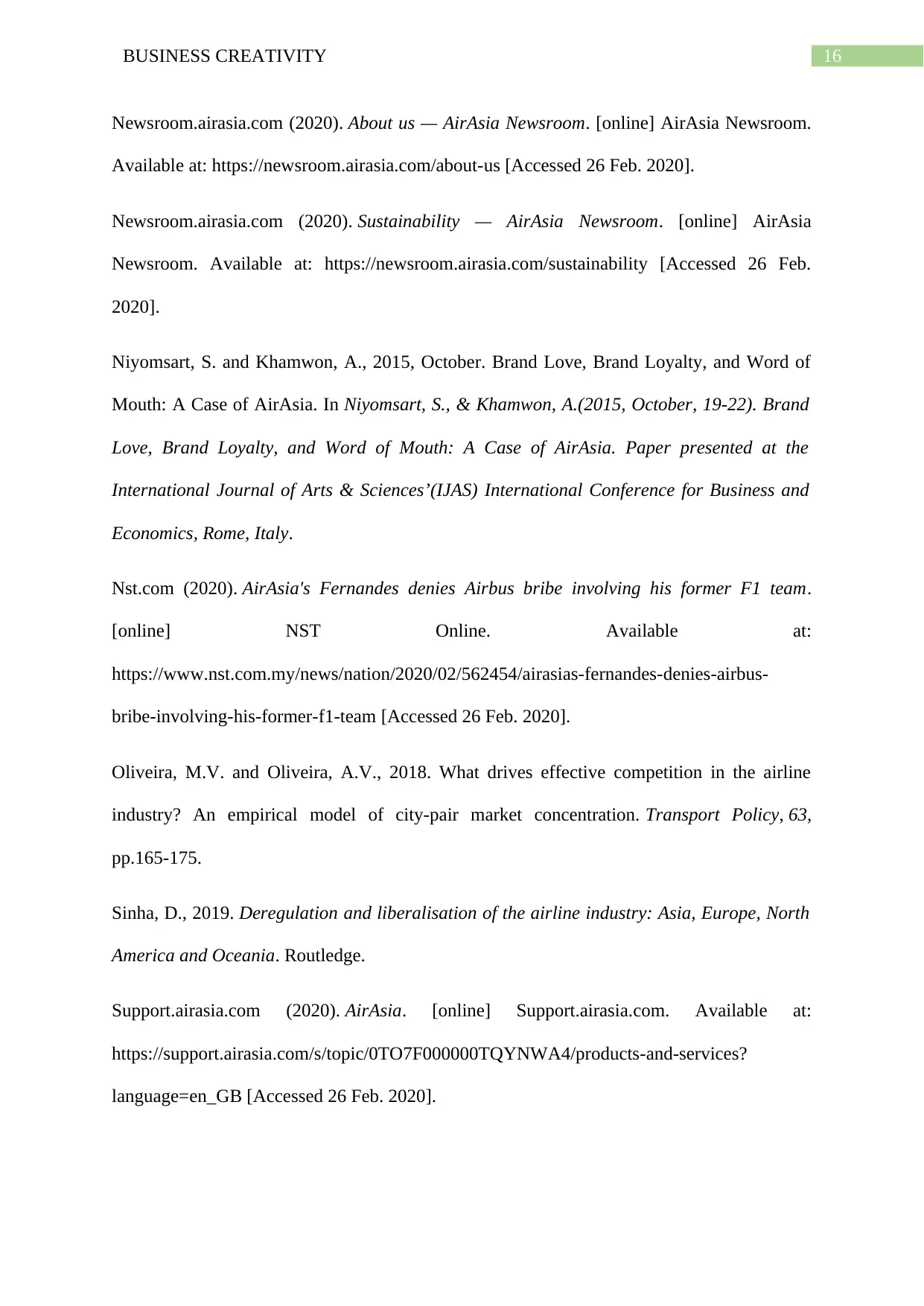
16BUSINESS CREATIVITY
Newsroom.airasia.com (2020). About us — AirAsia Newsroom. [online] AirAsia Newsroom.
Available at: https://newsroom.airasia.com/about-us [Accessed 26 Feb. 2020].
Newsroom.airasia.com (2020). Sustainability — AirAsia Newsroom. [online] AirAsia
Newsroom. Available at: https://newsroom.airasia.com/sustainability [Accessed 26 Feb.
2020].
Niyomsart, S. and Khamwon, A., 2015, October. Brand Love, Brand Loyalty, and Word of
Mouth: A Case of AirAsia. In Niyomsart, S., & Khamwon, A.(2015, October, 19-22). Brand
Love, Brand Loyalty, and Word of Mouth: A Case of AirAsia. Paper presented at the
International Journal of Arts & Sciences’(IJAS) International Conference for Business and
Economics, Rome, Italy.
Nst.com (2020). AirAsia's Fernandes denies Airbus bribe involving his former F1 team.
[online] NST Online. Available at:
https://www.nst.com.my/news/nation/2020/02/562454/airasias-fernandes-denies-airbus-
bribe-involving-his-former-f1-team [Accessed 26 Feb. 2020].
Oliveira, M.V. and Oliveira, A.V., 2018. What drives effective competition in the airline
industry? An empirical model of city-pair market concentration. Transport Policy, 63,
pp.165-175.
Sinha, D., 2019. Deregulation and liberalisation of the airline industry: Asia, Europe, North
America and Oceania. Routledge.
Support.airasia.com (2020). AirAsia. [online] Support.airasia.com. Available at:
https://support.airasia.com/s/topic/0TO7F000000TQYNWA4/products-and-services?
language=en_GB [Accessed 26 Feb. 2020].
Newsroom.airasia.com (2020). About us — AirAsia Newsroom. [online] AirAsia Newsroom.
Available at: https://newsroom.airasia.com/about-us [Accessed 26 Feb. 2020].
Newsroom.airasia.com (2020). Sustainability — AirAsia Newsroom. [online] AirAsia
Newsroom. Available at: https://newsroom.airasia.com/sustainability [Accessed 26 Feb.
2020].
Niyomsart, S. and Khamwon, A., 2015, October. Brand Love, Brand Loyalty, and Word of
Mouth: A Case of AirAsia. In Niyomsart, S., & Khamwon, A.(2015, October, 19-22). Brand
Love, Brand Loyalty, and Word of Mouth: A Case of AirAsia. Paper presented at the
International Journal of Arts & Sciences’(IJAS) International Conference for Business and
Economics, Rome, Italy.
Nst.com (2020). AirAsia's Fernandes denies Airbus bribe involving his former F1 team.
[online] NST Online. Available at:
https://www.nst.com.my/news/nation/2020/02/562454/airasias-fernandes-denies-airbus-
bribe-involving-his-former-f1-team [Accessed 26 Feb. 2020].
Oliveira, M.V. and Oliveira, A.V., 2018. What drives effective competition in the airline
industry? An empirical model of city-pair market concentration. Transport Policy, 63,
pp.165-175.
Sinha, D., 2019. Deregulation and liberalisation of the airline industry: Asia, Europe, North
America and Oceania. Routledge.
Support.airasia.com (2020). AirAsia. [online] Support.airasia.com. Available at:
https://support.airasia.com/s/topic/0TO7F000000TQYNWA4/products-and-services?
language=en_GB [Accessed 26 Feb. 2020].
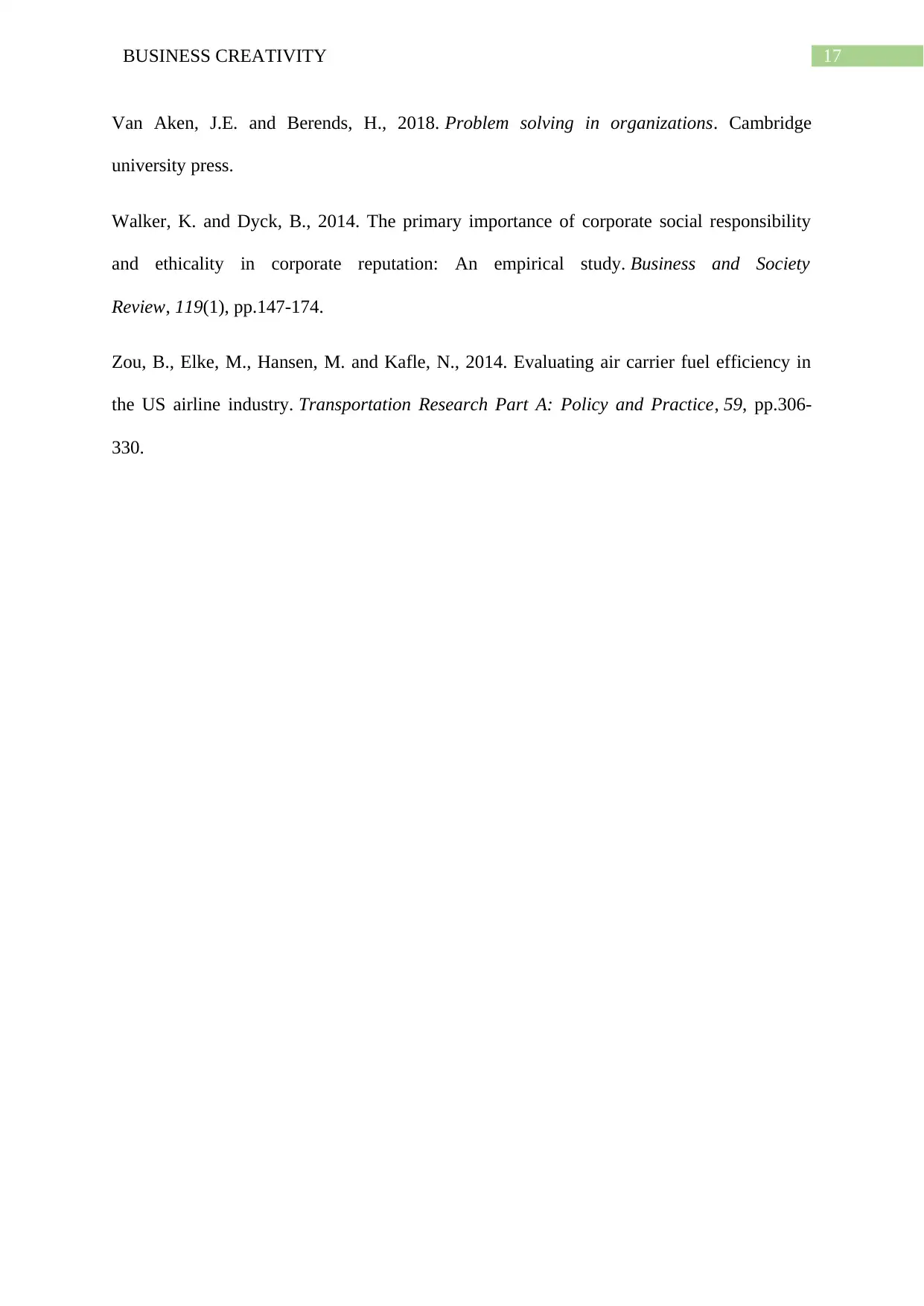
17BUSINESS CREATIVITY
Van Aken, J.E. and Berends, H., 2018. Problem solving in organizations. Cambridge
university press.
Walker, K. and Dyck, B., 2014. The primary importance of corporate social responsibility
and ethicality in corporate reputation: An empirical study. Business and Society
Review, 119(1), pp.147-174.
Zou, B., Elke, M., Hansen, M. and Kafle, N., 2014. Evaluating air carrier fuel efficiency in
the US airline industry. Transportation Research Part A: Policy and Practice, 59, pp.306-
330.
Van Aken, J.E. and Berends, H., 2018. Problem solving in organizations. Cambridge
university press.
Walker, K. and Dyck, B., 2014. The primary importance of corporate social responsibility
and ethicality in corporate reputation: An empirical study. Business and Society
Review, 119(1), pp.147-174.
Zou, B., Elke, M., Hansen, M. and Kafle, N., 2014. Evaluating air carrier fuel efficiency in
the US airline industry. Transportation Research Part A: Policy and Practice, 59, pp.306-
330.
1 out of 18
Related Documents
Your All-in-One AI-Powered Toolkit for Academic Success.
+13062052269
info@desklib.com
Available 24*7 on WhatsApp / Email
![[object Object]](/_next/static/media/star-bottom.7253800d.svg)
Unlock your academic potential
© 2024 | Zucol Services PVT LTD | All rights reserved.





